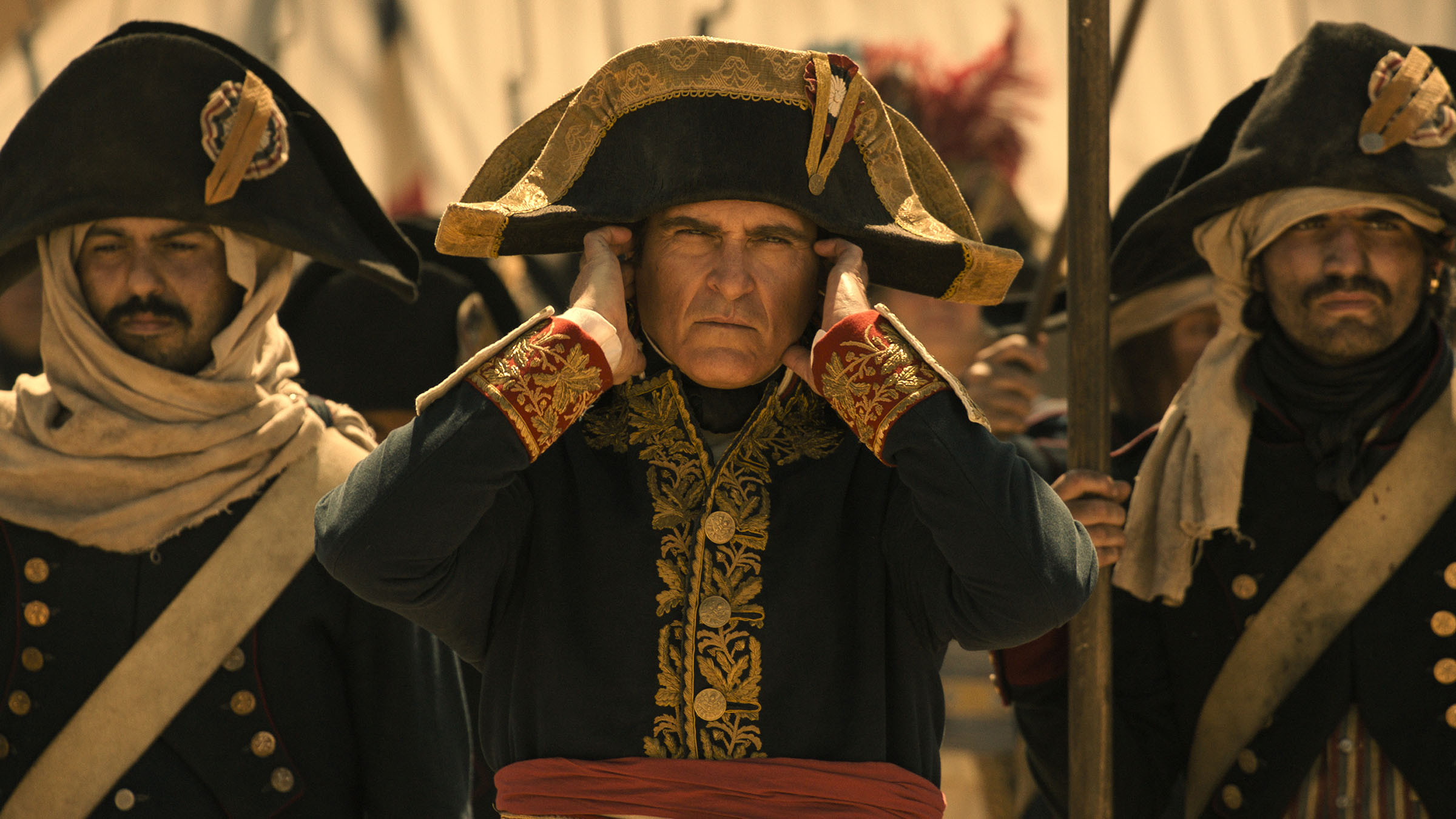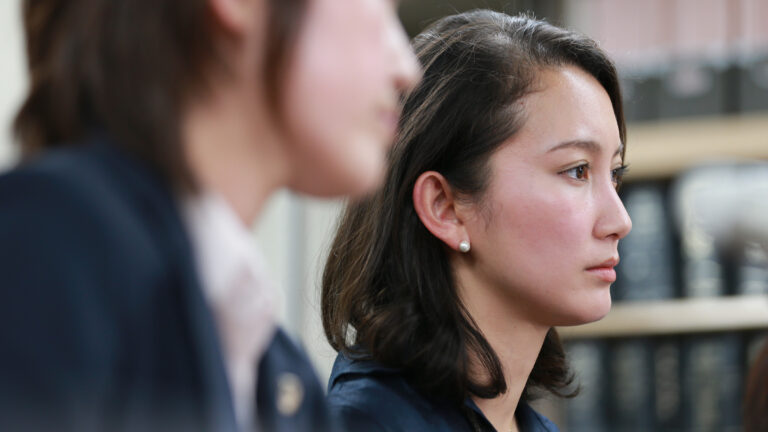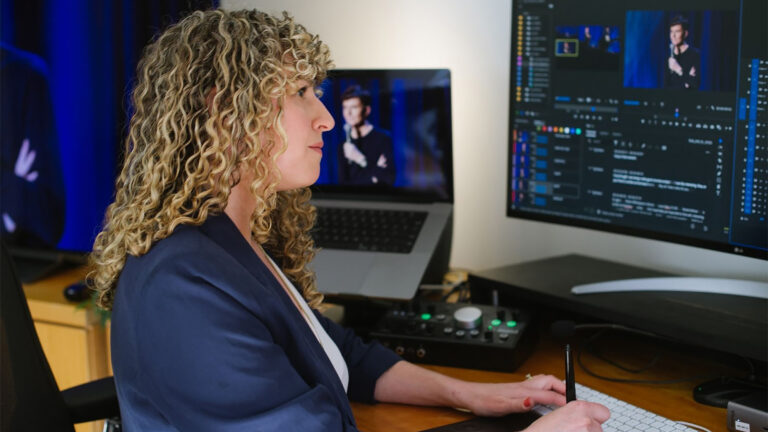Napoleon editor Sam Restivo credits the dutiful mentoring of Claire Simpson for how he found himself co-chairing the editorial duties for Ridley Scott’s latest film. Sam first worked with Claire as her assistant editor on the TV series Raised By Wolves (2020). From there, Claire brought Sam as her assistant to his first Ridley Scott feature, The Last Duel (2021). He would assist Claire one more time for Scott’s House of Gucci (2021) before getting the promotion for Napoleon.
Napoleon Plot Summary
Ridley Scott’s Napoleon is a look at the military commander’s origins and his swift, ruthless climb to Emperor, viewed through the prism of his addictive and often volatile relationship with his wife and one true love, Josephine.
In our discussion with Napoleon editor Sam Restivo, we talk about:
- Going entertainment first, history lesson second
- Holding off on the V.O. until the end
- How sometimes subtitles are just funnier
- Turning 72, 48 and 36 frames into 24
- The Legend of Claire Simpson
Listen while you read…
Editing Napoleon
Matt Feury: There’s a sentiment in the press that this film is not a biography. It’s not meant to be a detailed historical account, but rather an exploration of Napoleon as a person and his love affair with Josephine and France. How much did you know about Napoleon and French history going into this?
Sam Restivo: I only knew what I learned in high school. I’m just a normal American person. Ridley is awesome about cluing the editors in early. We get advance copies of the script. He also had this thirty-five-year working relationship with Claire Simpson. He’ll send the script to her and ask, “What do you think? Do we need all these scenes?”
The thing that impacted us was, “What would the music of the time have been?” We were already looking at classical needle drops before the shoot. We had multiple phone calls with Ridley discussing various classical composers.

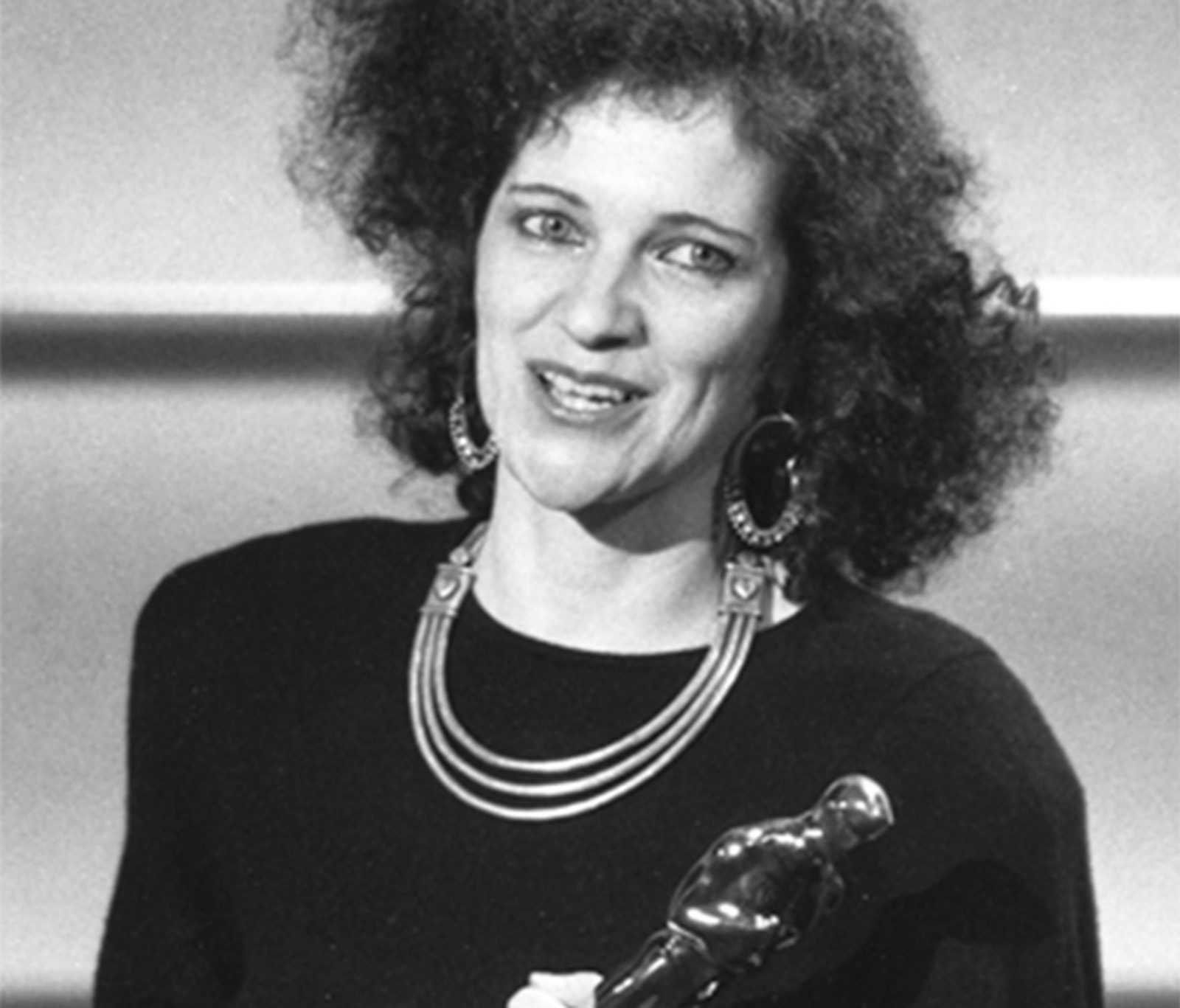
MF: Since you mentioned composers, composer Martin Phipps talked about how Stanley Kubrick’s film Barry Lyndon, was a point of reference for the tone of Napoleon. That makes sense because Kubrick developed Barry Lyndon out of research he had done for a film about Napoleon that never got off the ground. Did Ridley give you any references to draw from?
Sam Restivo: The North Star for us was Barry Lyndon. We all love that film. We were editorially leaning on its ironic sense of humor. That movie is far drier than ours, but Ridley didn’t mind, at least in the initial assemblies, that it was pedantic and held on its shots a little bit longer. Once we got down to refining things, we started trimming shots a little bit. We just had so much story to tell.
MF: Do you typically feel like it’s incumbent upon you to do a lot of research before you start working? Or do you just say, “This is the script I got, these are the dailies I’m getting, and that’s all I need.”
Sam Restivo: A little bit of both. I did some research, but I didn’t read all of the Napoleon biographies or anything like that. And I knew that we weren’t doing a documentary. Once I saw the script for the first time and saw the tone of what it was going to be, I thought, “No, this is all that I need” and went from there.
MF: What, if anything, did Ridley say about what he wanted to accomplish with this movie?
Sam Restivo: He is very cognizant of wanting to entertain the audience. It’s two ways. Ridley is making the film for himself. If he’s happy with it, then that’s all that matters. And he’s earned that because of the insane amount of experience that he has.
Ridley is making the film for himself. If he’s happy with it, then that’s all that matters.
On the flip side, he’s also aware that people are going to pay money to come to a movie theater and see it. So, he was always encouraging us to lean into the entertaining side of the show. Take the battles, for example. That’s just Ridley Scott. That’s what he does. It’s his bread and butter. But the humor in the intimate scenes between Joaquin and Vanessa, he said, “Let’s have this be as enjoyable as it can be.”
MF: Regardless of what you already knew about Napoleon going in, you’re going to have audience members who know very little. I’ll raise my hand for that. What did you and Claire do to give the audience some context, or at least the necessary minimum knowledge about this period and these people?
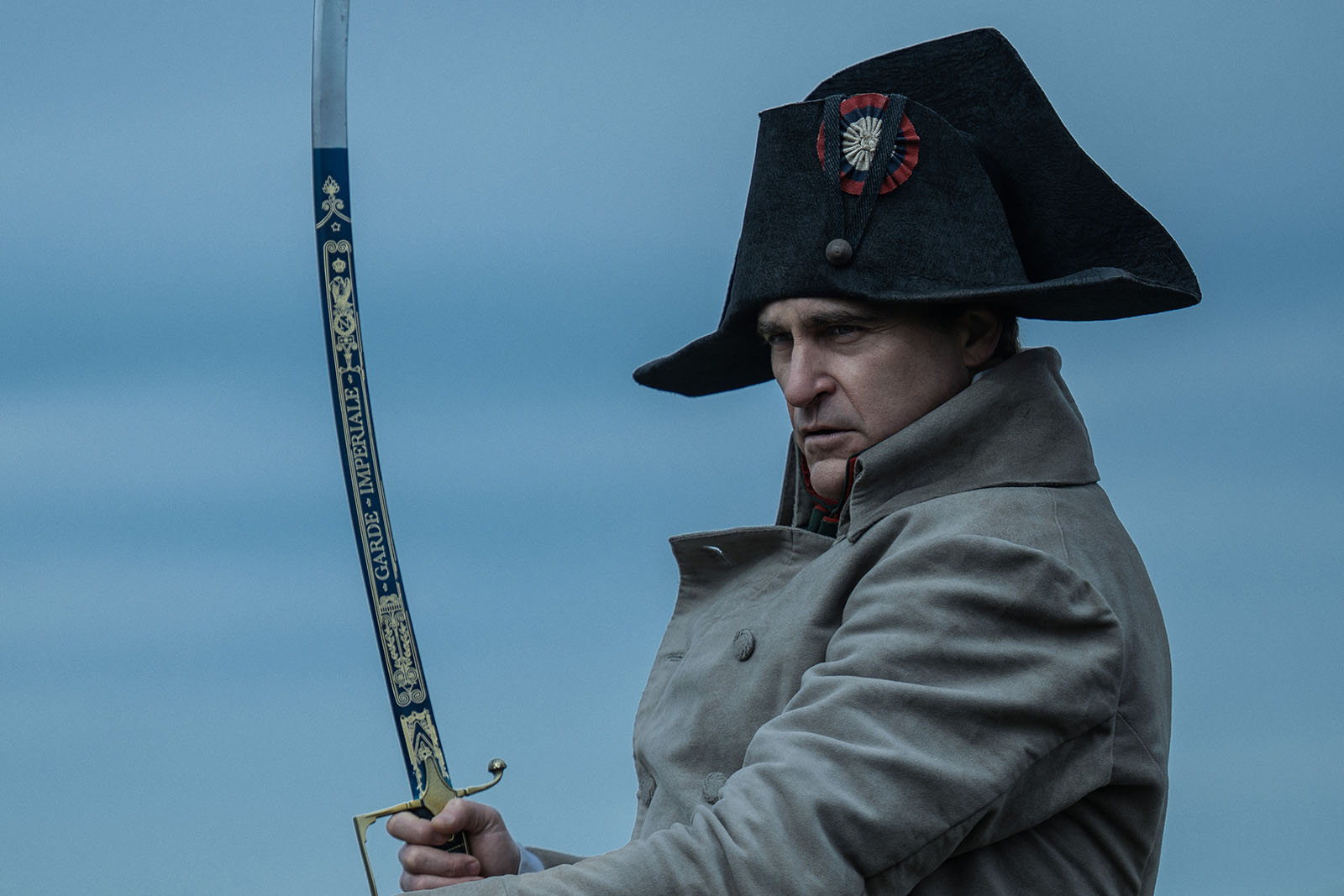
Sam Restivo: The legend at the beginning was a whole thing. We spent forever trying to figure out exactly how many lines there should be and how we should set up the world, Marie Antoinette, and the revolution in France. We also needed to let people know that Napoleon himself was not French, that he was Corsican. That’s why that last line of, “an ambitious young Corsican Lieutenant” went in.
We were trying not to overwhelm people with dates and settings, but we knew we had to include some just to accomplish the passage of time and to orient people.
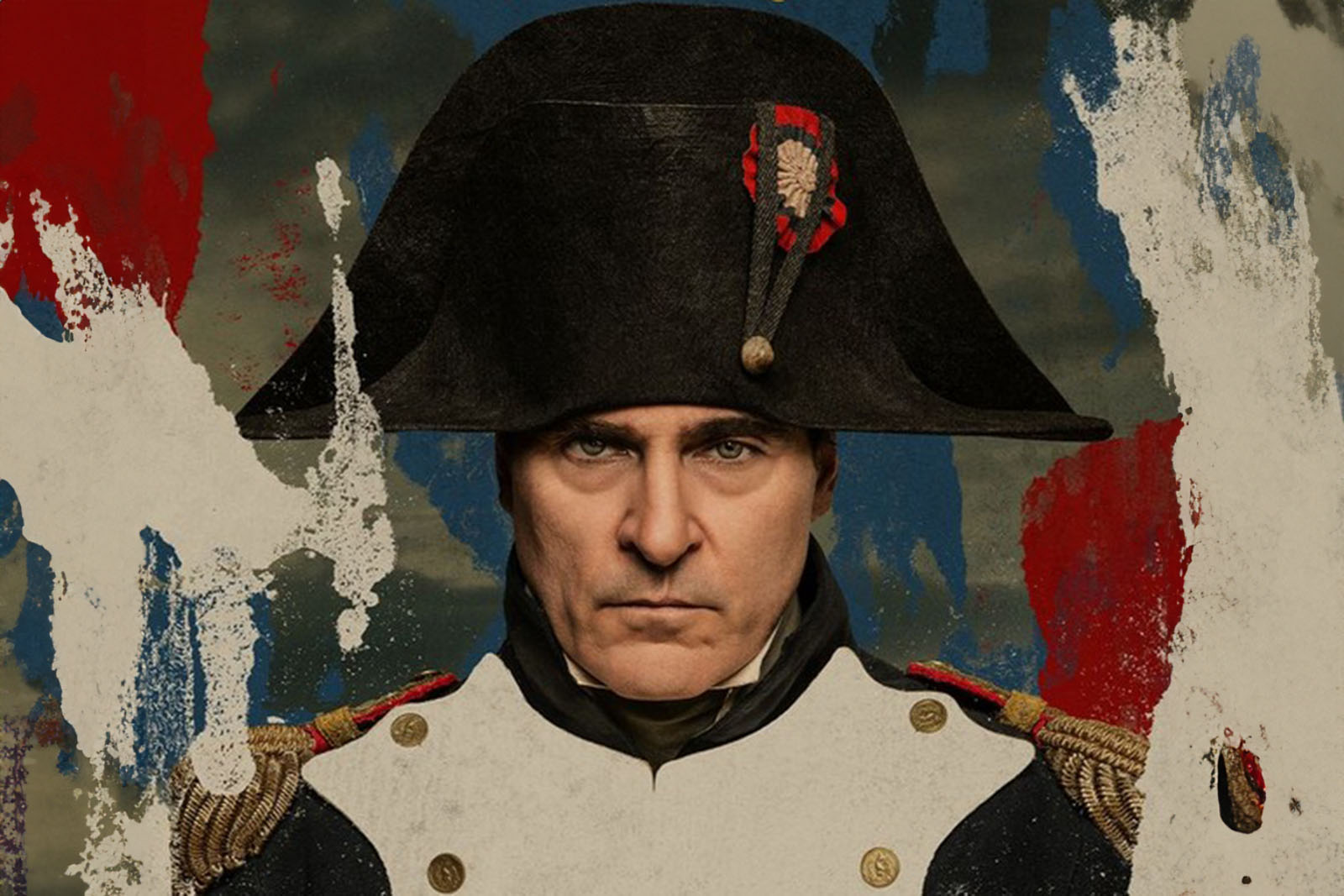
MF: There are some things you’re going to need to explain to the audience. Certain characters, for example, are given title cards when they appear on screen, but not everybody. It’s just for very specific characters. Why those characters? What sort of discussions did you, Claire, and Ridley have that eventually led you to this?
Sam Restivo: Whenever there was an important military advisor, they got a card. Junot (played by Mark Bonnar) didn’t get one because he was only in the first part of the movie. But both Caulaincourt (Ben Miles) and Talleyrand (Paul Rys) had massive parts throughout the entire film, so we wanted people to casually be aware of them.

Talleyrand shows up at the very end as part of the Congress of Vienna. He’s one of the guys that turns on Napoleon, so we wanted him to have a card. We also didn’t give too many cards because we didn’t want to overwhelm the audience with too many things.
MF: Please tell me that you and Claire had some sort of French Revolution family tree where you could keep track of all these people. These names, titles, and roles have got to be overwhelming.
Sam Restivo: It was. There were multiple historians involved with the film. Countless people were correcting the facts and figures that we were working with. Getting exactly the right title was something that went through multiple revisions. Different historians said, “No, it would be something closer to this at the time.”
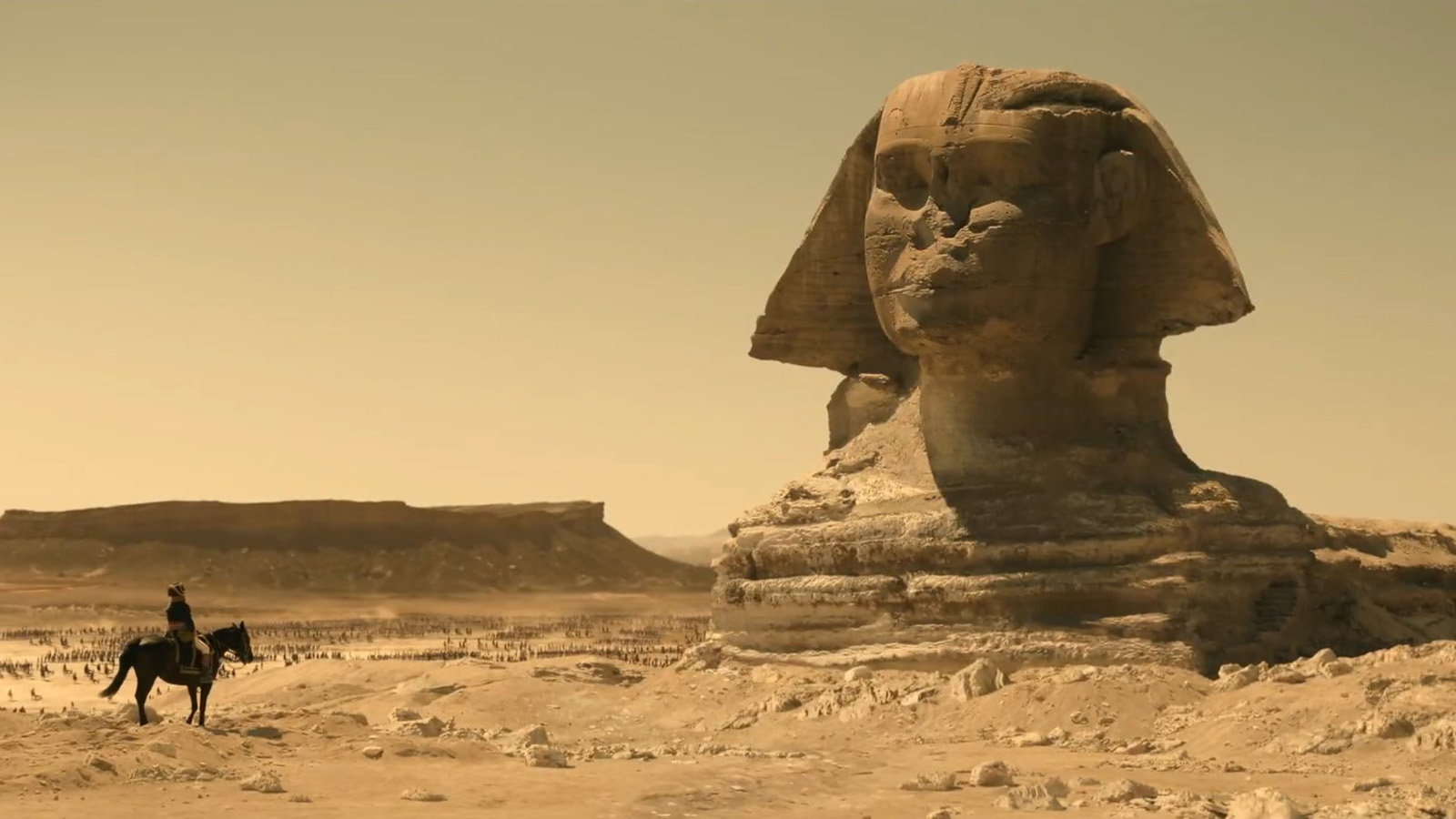
MF: During post, would you have check-ins with these historians where they would do a review of your cut?
Sam Restivo: Yes, that happened multiple times. Right at the very end, Sony had a different set of Napoleon historians come in to give us notes. We had to go back and revise some titles. It was mostly about the actual number of dead at the end because it is a bit open to interpretation. With a battlefield like Waterloo, it’s hard to get the total number of people that died. There’s going to be different schools of thought about what those numbers should be, if you’re going to include all sides and civilian deaths as well.

MF: Did any of these historians ever get too comfortable and lean in and go, “Sam, the pacing right here is not doing it for me.”
Sam Restivo: No, no. Thankfully, no.
MF: There’s another element of the film that I think you leaned on to help set up context. The letters between Napoleon and Josephine serve multiple purposes. They provide context and they work as transitions between scenes. Was that text derived from actual letters? How did you go about employing those pieces of connective tissue?
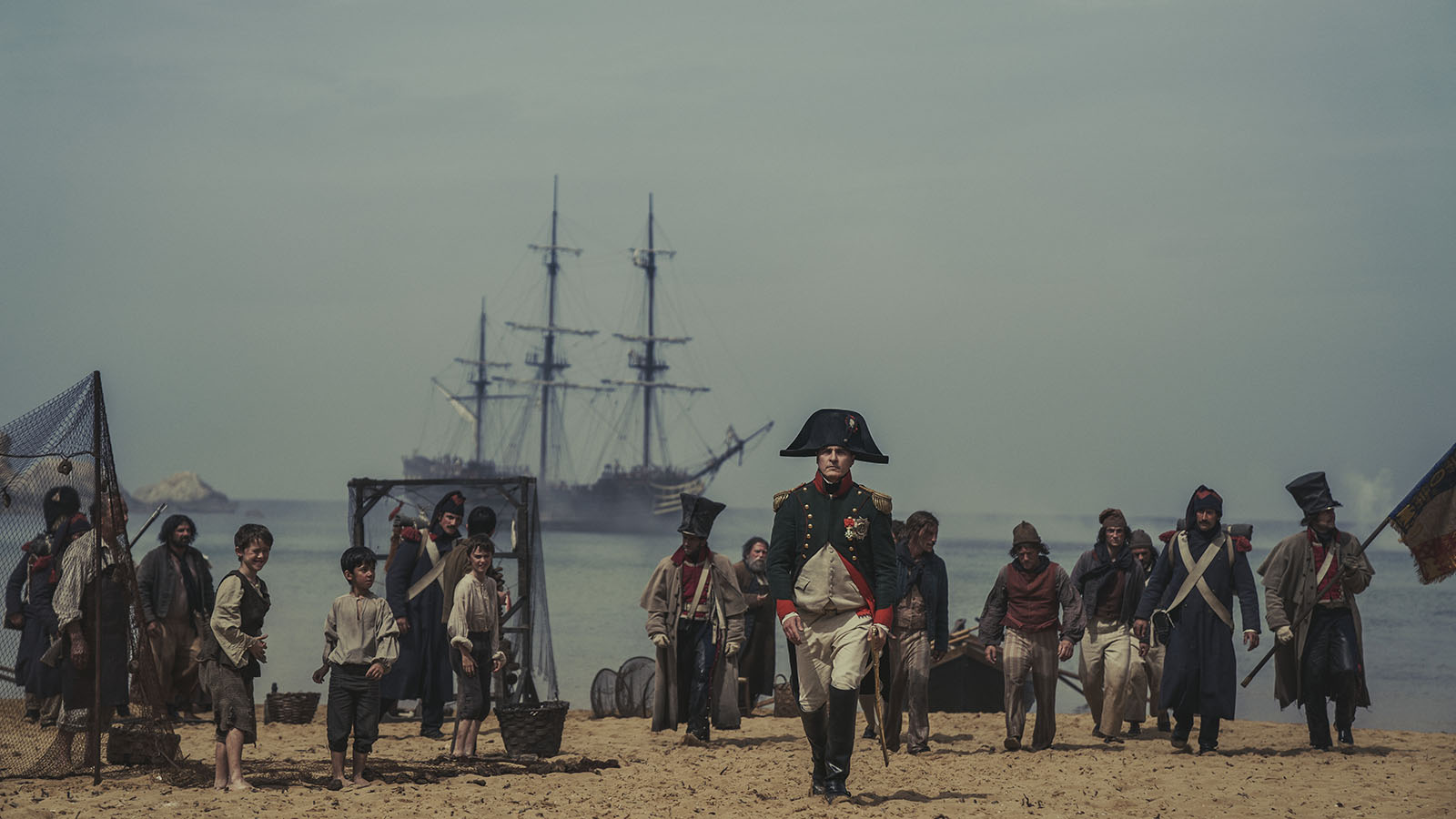
Sam Restivo: The writer, David Scarpa, referenced actual letters from Napoleon. There are hundreds of letters from Napoleon to Josephine, but very few letters from Josephine to Napoleon. So there was a little bit of figuring out that had to be done for her letters.
We had Joaquin record for us while they were shooting, but we didn’t employ the voice over until pretty late in the game. We knew it was going to come in, but we wanted to cut the scenes beforehand to see if we could not do voice overs.
What we were missing was that extra layer of understanding between the two of them. We also wanted to keep them connected for those long stretches of screentime. For example, Josephine got a letter when Napoleon was going through Russia, and that was an important thing to keep her included.
The controversial one for us was the final letter, which was read after she died. We realized that didn’t make sense, but it’s a fascinating thing to suddenly conjure her into Napoleon’s mind. She was literally haunting him after her death. Ultimately, we decided it was super cool.
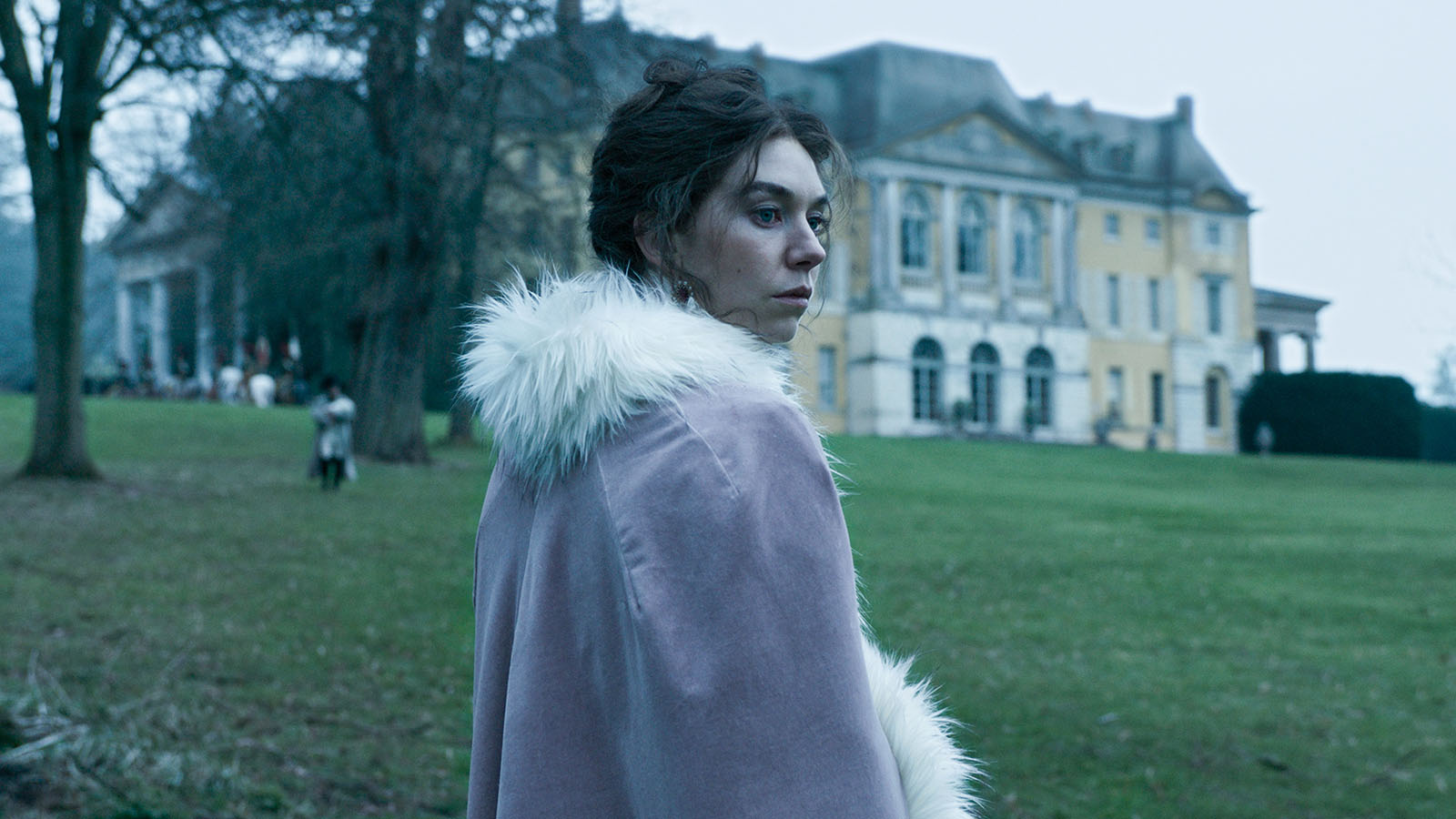
MF: I was not sure when that letter was supposed to have been written. Did she write it before he came back from exile? Where does that letter fit in the timeline?
Sam Restivo: That letter, by the way, is an amalgam of a variety of different sources from Josephine. That one would have been written while he was on the way back from Russia.
MF: So, for the ending, it’s the sentiment of what she’s saying rather than the context that matters.
Sam Restivo: Yes, exactly.
MF: The letters are a point of transition between scenes. Then there’s a stylistic transition you did a few times. You faded up to white. I think you only did it a couple of times, though.
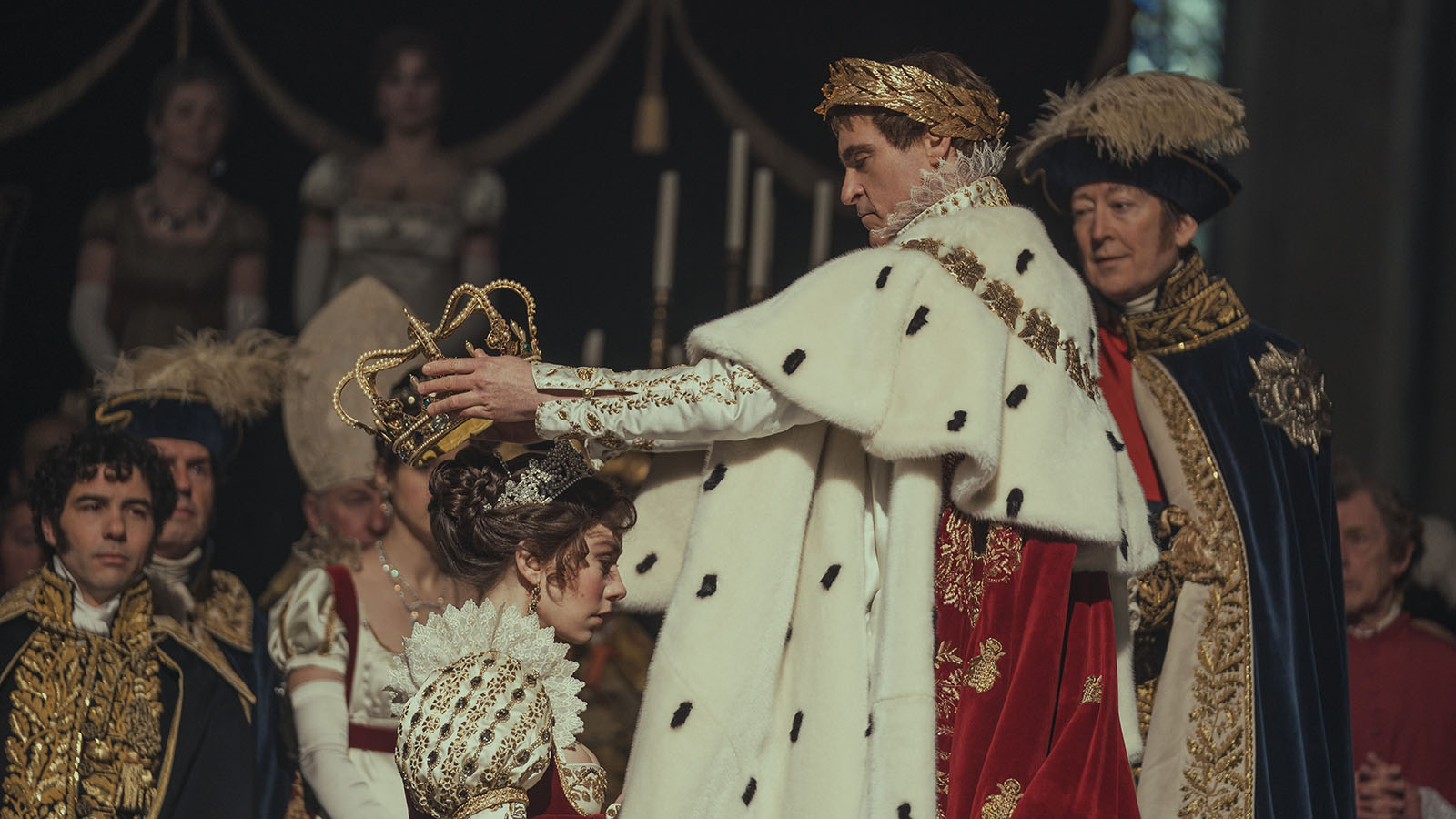
Sam Restivo: Twice. That was a Ridley thing. He knew we were going to have a big explosion at the end of the Siege of Toulon and he liked the idea of going full white out there. We introduced Josephine at the end of the Reign of Terror, and he liked that flash to white landed on this mysterious person walking through the streets of Paris. He loved that image, so we went with it.
MF: One thing people are hearing about is that the actors speak in their natural accents. But you deviate from that at least once in the film. There’s a scene where Napoleon is trying to build bridges with Austria. He sends an emissary to suggest the king’s daughter should marry Napoleon, and that is done in Austrian with subtitles. Why?
Sam Restivo: They shot it both ways, once in English and once in Austrian. We just loved the Russian ambassador’s performance so much. And the joke played better in the Austrian version. The cadence of the way they spoke to each other was funnier to us.
MF: Were there other instances that were shot both ways?
Sam Restivo: Not really. There was some Russian stuff with Tsar Alexander. That actor, Edouard Philipponnat, speaks Russian. But we had already put so many title cards and dates in that we didn’t want to also put a ton of subtitles. It made sense in that one instance because we were making a joke of it. It was clearer and funnier that way.
MF: I don’t want to just breeze past that decision to let the actors speak in their native accents. Was it that way from day one?
Sam Restivo: We weren’t party to the discussions that went on with that, but we do that Joaquin wanted to do it that way. He didn’t want to complicate things by trying to do a French accent. He didn’t want that to be the thing that people were commenting on. I’m assuming that they followed his lead for that.
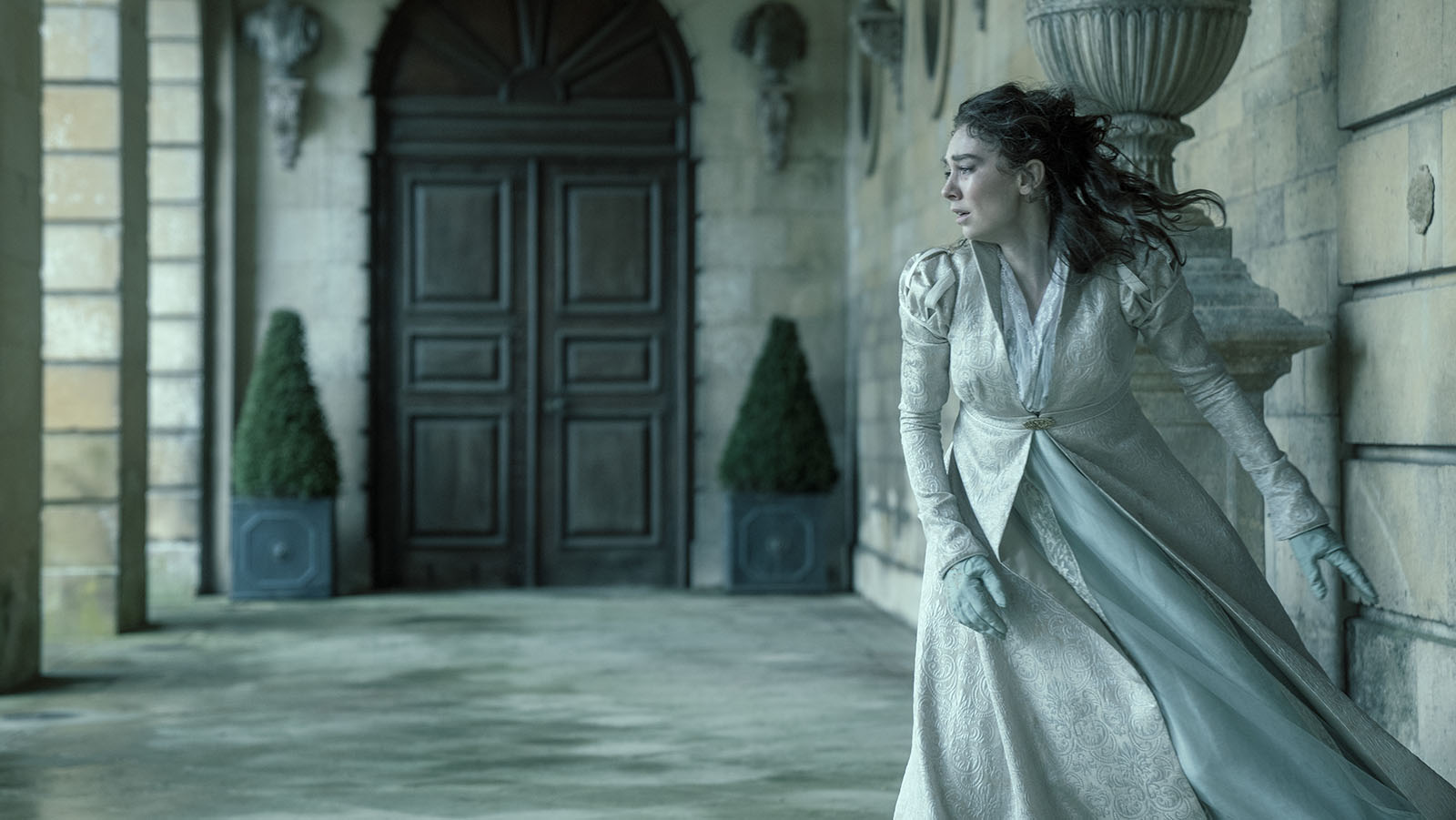
MF: Two hours and thirty-eight minutes might sound like a long runtime for a film, but when you consider that you’re encapsulating Napoleon’s rise and fall, that’s very little time to tell that story. What aspects of this story did you wrestle with the most in terms of getting the point across without slowing down the pace?
Sam Restivo: Our first assemblies of the battles were twice as long, not because there were more story beats, there was just more battle. There were more horses and more fighting and all that fun stuff. When we were watching early cuts of it, we felt like it was exhausting. We felt we needed to rein each battle in so that we could center the Napoleon and Josephine relationship. Pretty much everything we shot of their relationship made it into the movie.
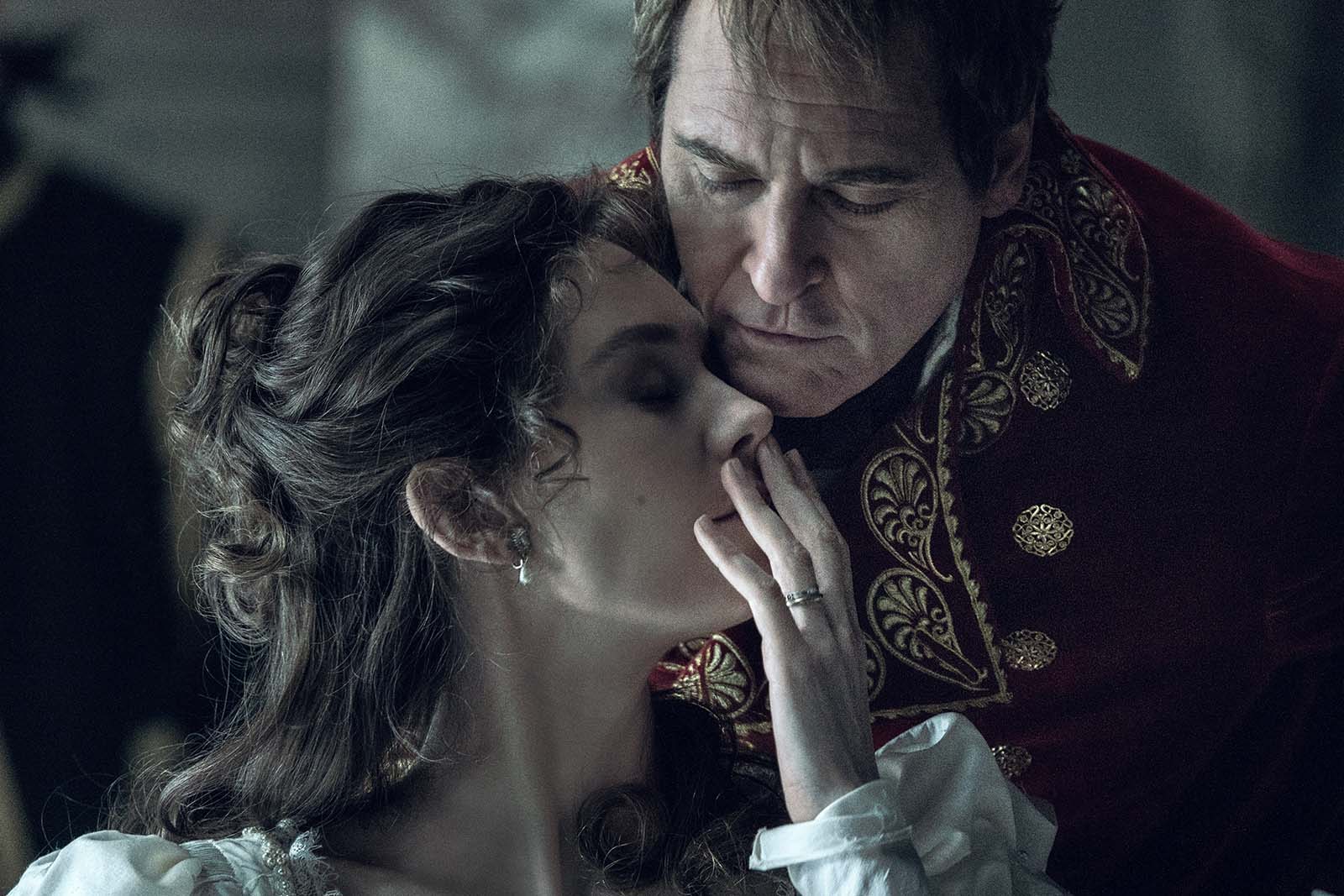
MF: Before the film came out in theaters, it was announced that there would be a four-hour director’s cut released on Apple TV. Does that change the process for you at all? How do you address the director’s cut knowing that it’s going to be released?
Sam Restivo: Two hours and thirty-eight minutes was always our intention for a theatrical release of the film. We were always aware of the overall length. We decided that two and a half hours was the most we could force onto a captive audience.
Again, there’s just so much history. The battle scenes are so intense. And the film’s sense of humor is probably unexpected. We wanted to make it palatable for the majority of audience members. Two hours and thirty-eight was perfect for us. Ridley was on board with that running time.
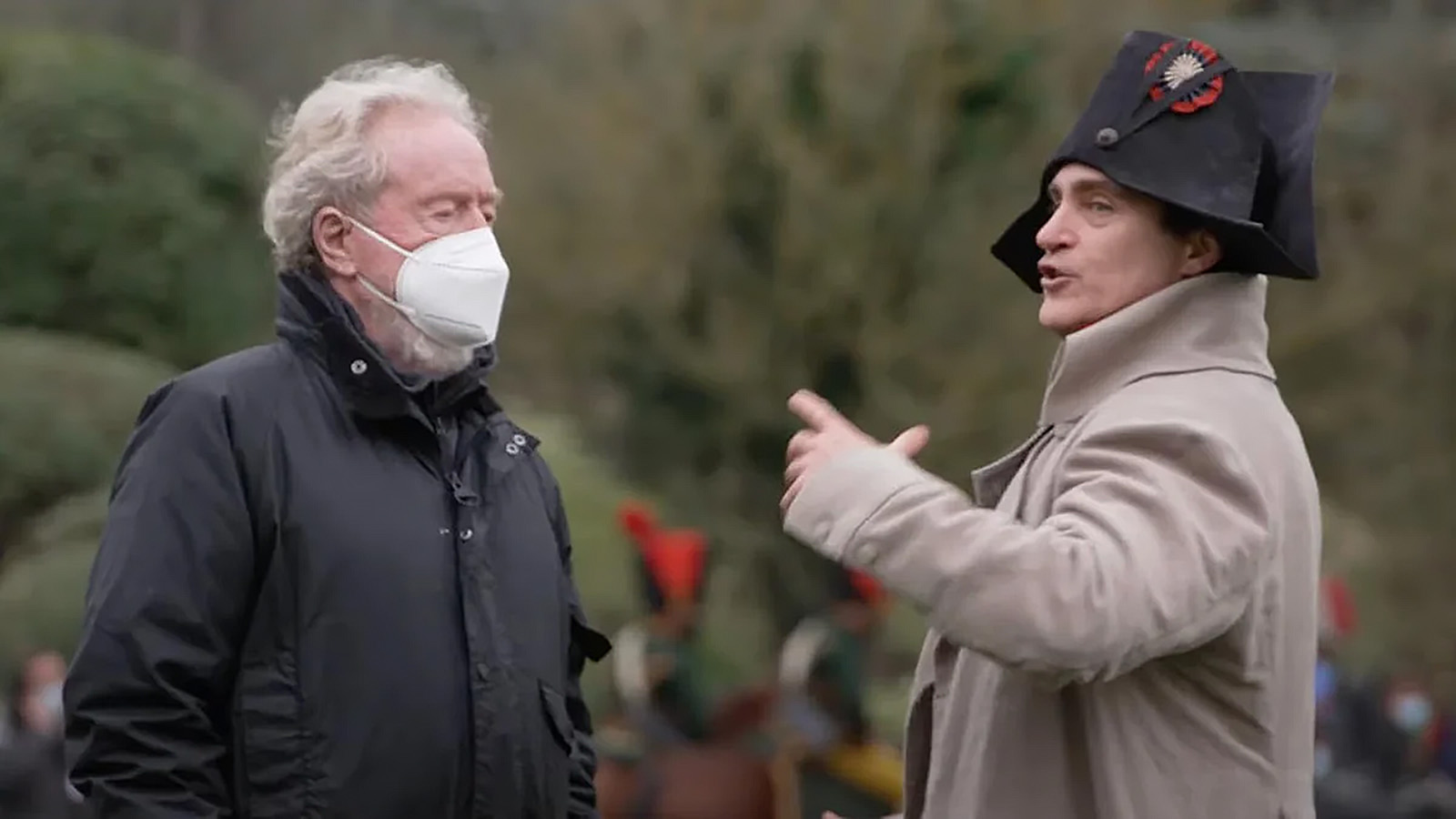
Having said that, the screenplay that David wrote was 130 pages long but there were 239 scenes in it, which is crazy. It was such a huge thing. So, we had a lot of different options editorially. There were lots of different directions that we could go.
We were not going to have a twenty-five-minute version of the Battle of Waterloo!
We were always going to focus on the relationship between Napoleon and Josephine. In our first assembly of the movie, we put every scene in to show it to Ridley. It was not even an editor’s cut or anything like that. It was a straight assembly that was four hours and thirty-three minutes long, which was crazy talk because the movie was never, ever going to be that long. We were not going to have a twenty-five-minute version of the Battle of Waterloo!
When we started cutting the scenes down, we realized that maybe we were repeating some thematic things or beats. We just didn’t need to have all of that in there. But for a streaming environment, if this happens, there are plenty of extra bits that people at home might enjoy seeing if they’re fans of the film.
MF: Well, I’m looking forward to the four-hour director’s cut. Let’s talk about the comedy of the film. There are these comedic beats that are just sometimes ludicrous.
In one scene, Napoleon is arguing with a British general and he shouts, “You think you’re so great because you have boats!” It got a big laugh from the audience I saw the film with. How do you know when to play up the comedy and when not to?
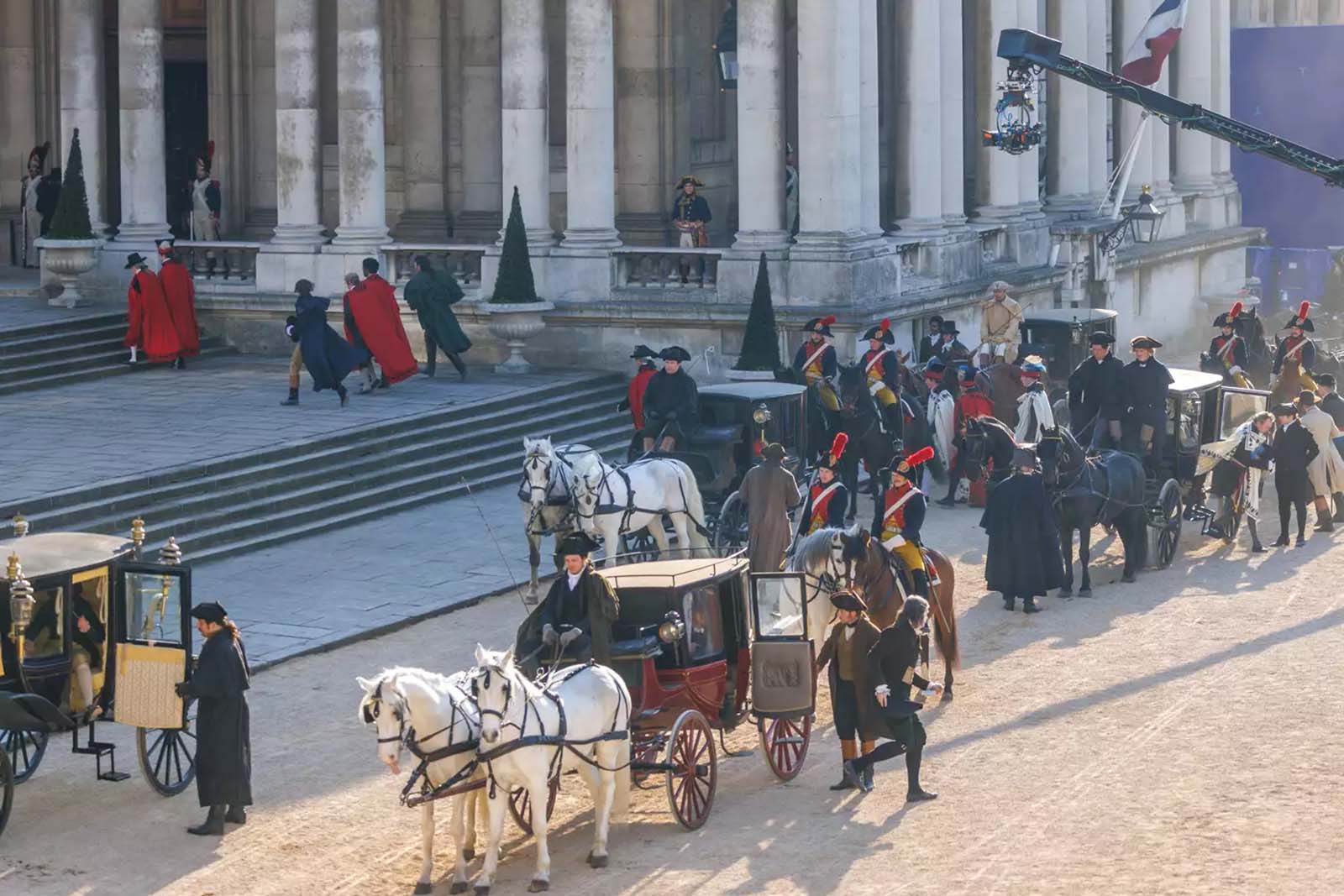
Sam Restivo: We were threading the needle a bit with that. Lines like that one and the lamb chop line are not necessarily anachronistic per se, but they are very literal and very funny. And we don’t have too many that are like. We knew this film wasn’t a slapstick comedy or anything like that.
We knew what the script was, but when Claire and I got dailies, we would go through and see what the actors were giving us. We’re the first audience in that case. So, whenever something amused us, we put it in to see if it could stick. Ridley was on board with that. He always loved seeing if we had a slightly different take on how a scene could be played. He loves to be surprised. Editorially, one of the ways we could do that was by cutting it to make it a little bit more comedic.
He always loved seeing if we had a slightly different take on how a scene could be played.
There’s a scene we call the ‘look down scene’, as we call it. In it, Josephine says, “Look down and you’ll see a surprise.” Claire did that scene. The first time we showed it to him he was in stitches. That was the first time he said, “This is it. This is the tone.”
It’s a beautiful contrast to the presentational way that stately people have to use when they go on a date. She’s saying this very lurid thing and she’s first also showing her power and being a seductress. Ridley just ate it up. He thought it was hilarious.
The first time I showed him the cut from the dinner scene to the sex on the bed, he almost fell out of a chair laughing. He said, “Yeah, this is exactly the tone that we wanted.”
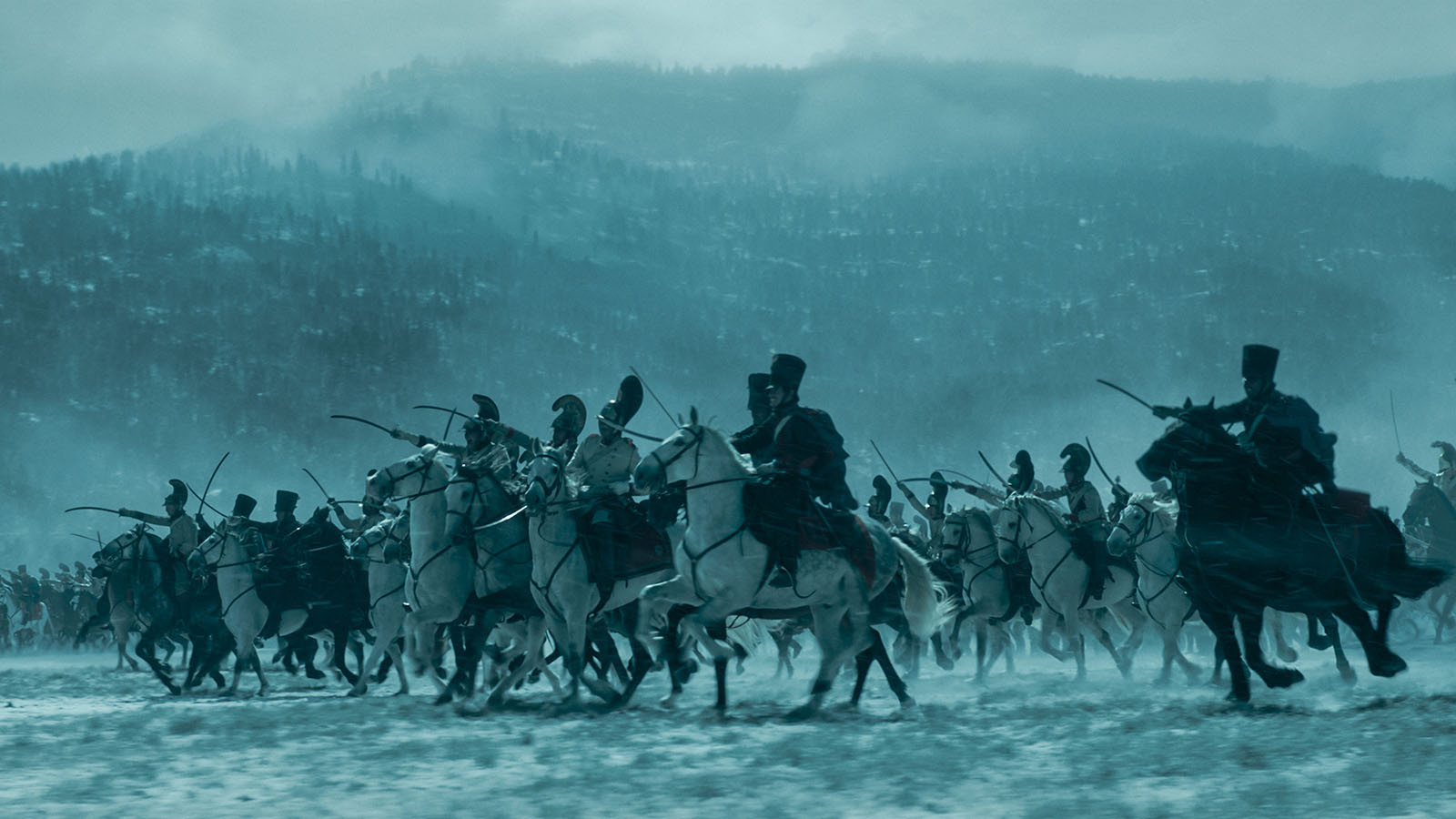
MF: Claire, unfortunately, couldn’t join us today. Let’s talk about how you two divided the workload. How do you divvy up such a big film? How do you stay in sync once the work does begin?
Sam Restivo: The first thing I should say about Claire Simpson, who is one of the greatest film editors of all time, is that her commitment to mentorship is beyond admirable. The editors that have come up under her are some of the best of all time. I am immensely grateful for the last five years of my career.
I was hired on Raised by Wolves as her first assistant and we hit it off right away. She was giving me things to cut early on, and that blossomed into more on The Last Duel and more on House of Gucci. She then wanted to share the duties entirely on Napoleon.
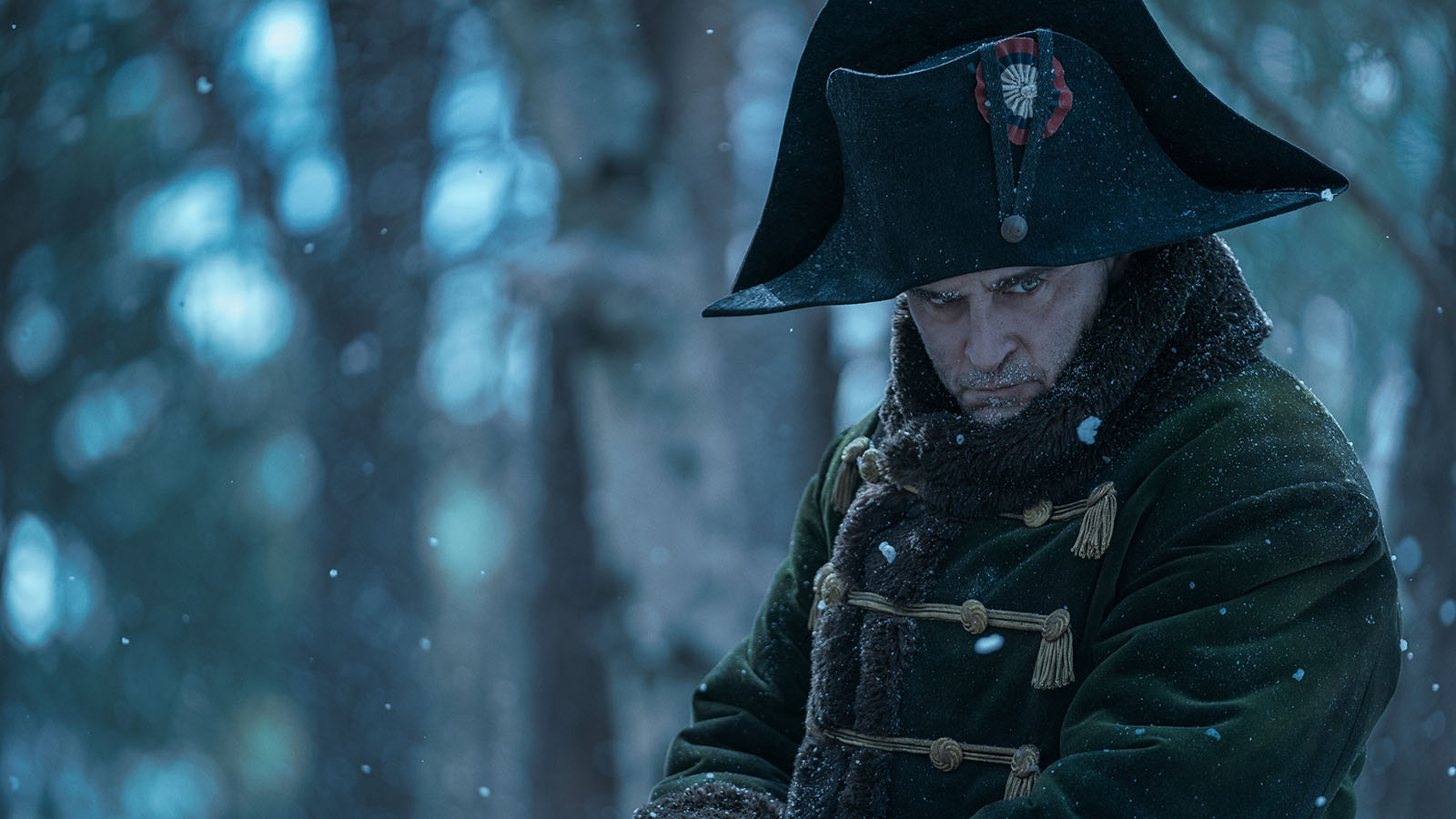
The way that it works is that we will sit together and watch the dailies from the day before. Because it’s Ridley, there were usually nine or more cameras working at the same time. We would watch all nine cameras in a split view on the Avid. Otherwise, we would have never gotten through it all.
Once we watched all the dailies, we would say, “Okay, which scene do you want?” and we would divide it up on the day. When it came to the sequences that took more days, like the battle scenes and whatnot, Claire would say, “You take Waterloo. I’m going to do Austerlitz.”
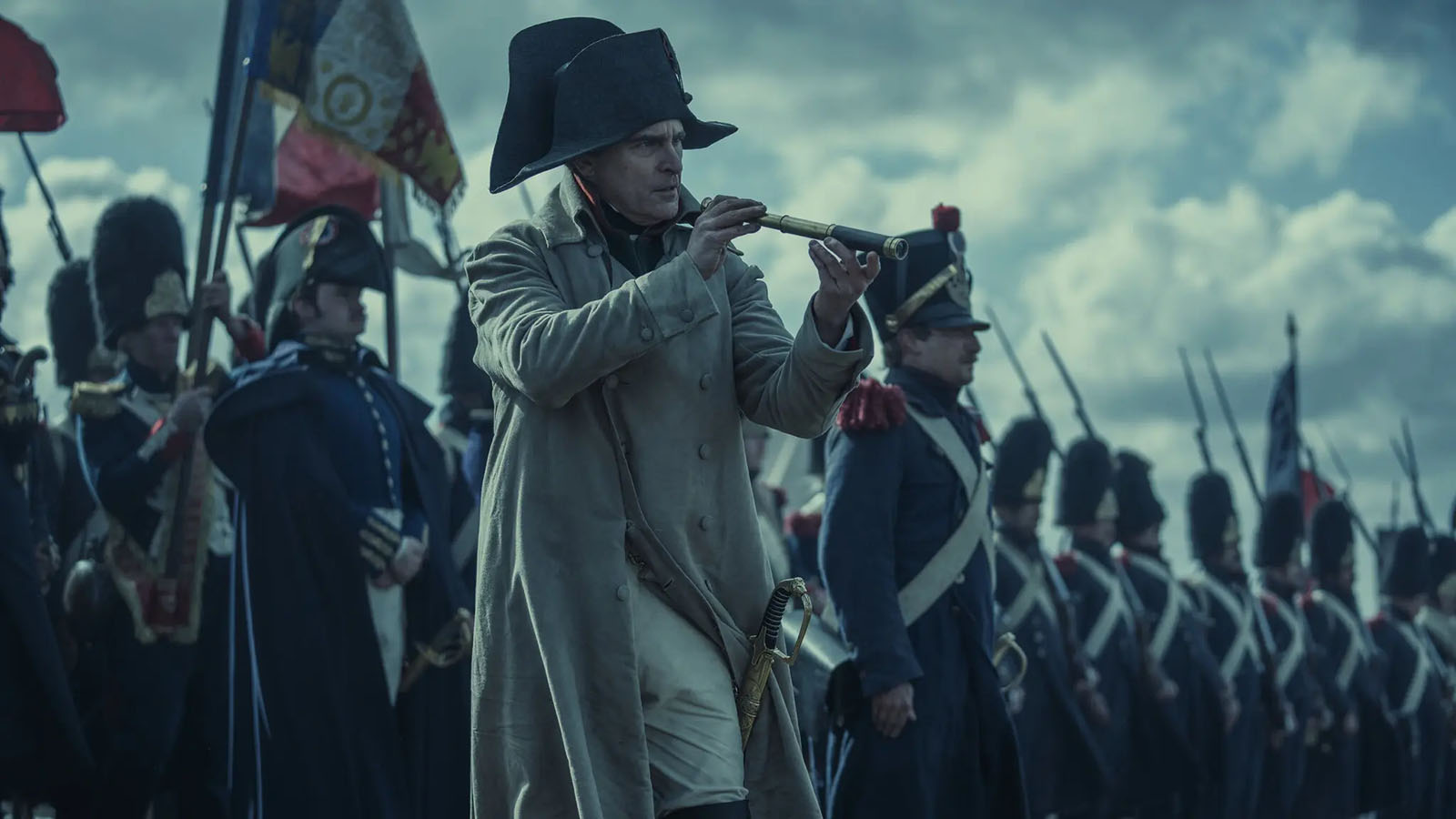
During the production phase, we had to keep up with Ridley’s breakneck pace of shooting. They’re hurtling through locations and sets and it was incumbent upon us to be caught up to camera. We had to be, or we would never be able to catch up. It helped to have two editors for that alone.
During production, we would divvy up the dailies and then we would cut away. We would show each other our cuts a few days later and get feedback. Occasionally, Ridley would pop in, usually on a Saturday. He would always say, “Only show me when you’re ready.” We’d show him that were done early and he would say, “Yes, I love it.” and we used that to keep going through the shoot.
We needed to have the entire film assembled to show Ridley by the last two production days. Ridley was going to depart immediately after the shoot, so we had to have the entire film assembled before he left. We showed him the whole movie and it was four hours and thirty-three minutes. His main reaction was relief. He said, “Oh my God, there’s a movie.”
It wasn’t that he didn’t think that he could do it, but I can only imagine that, as a filmmaker, you’re working at this breathless pace and doing all these scenes just hoping that it’s going to work out. He was so, so relieved and so elated that he had something.
Once we had the assembly done, it was the two of us sitting together at one Avid. We would trade who was driving by the day and we went from start to finish through the whole movie. Ridley would say, “When you’re ready, I’ll come in and watch something.” That’s how it was for the rest of the cutting process.
MF: It sounds like he has a very relaxed approach to working with editorial.
Sam Restivo: Yes. What’s amazing about working with Ridley Scott is that there’s an aura about him. He is an icon and a legend. There’s no question. People think of him as a very dry British guy, but he’s hilarious. He was always telling us jokes and keeping things light in the cutting room. He’s also very respectful. He’s known Claire for a long time. Like most of the other department heads working on his movies, we are trusted members of the team. He trusts us.
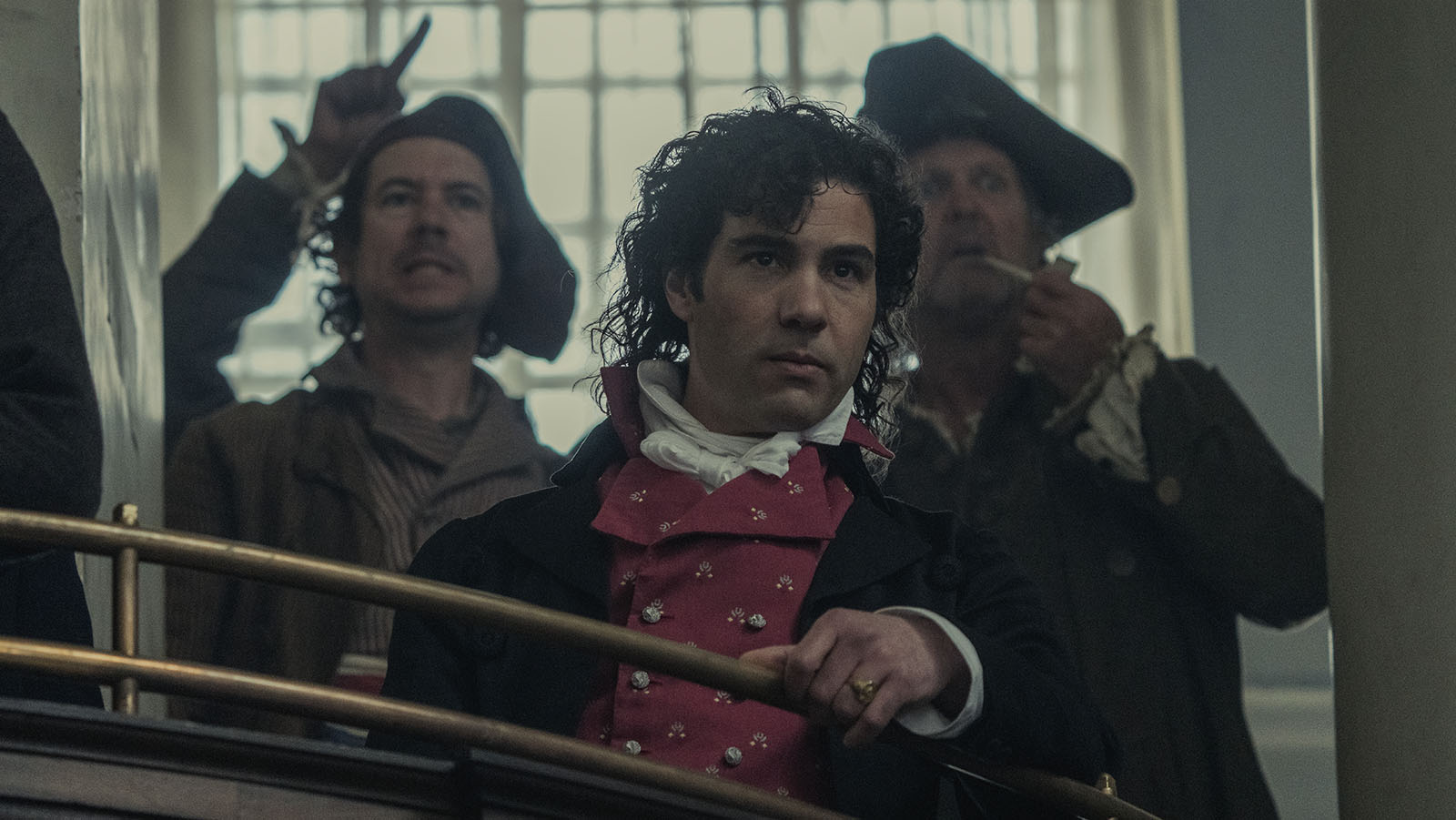
Ridley also gives us hand-drawn storyboards, which act as a roadmap for what the movie is going to be. We know where he’s going, but he lets us run wild with it and go in whatever direction that we want to.
That very first screening that we show him is always, for us, the most important. We are showing him what he shot, but we’re also trying to surprise him with something out of the box as well. He loves that. He’s a fantastic collaborator in the cutting room and super respectful and a lot of fun to be around.
MF: As you said, battles are Ridley’s bread and butter. They’re just amazing. What is the evolution of something like a Waterloo or Austerlitz battle? Does it start with animatics, storyboards, and previs? What are the elements that you get to start building this out?
Sam Restivo: Ridley often says that his most enjoyable moments are the early days of a film. He was already drawing all of the storyboards for Napoleon while we were finishing House of Gucci. He drew every single frame that he knew he wanted. Those storyboard references go out to every department, including ours, because he puts it in the order of how he thinks the cut might go. We have that as a reference.
As far as previs, there’s not much. They did a little bit for Austerlitz because it was a very complicated section. But honestly, we didn’t end up using most of the previs in the cut. We just followed his storyboards. That’s the main thing we go off of from the beginning.
MF: Are the storyboards purely just a reference or do they get scanned into the Avid?
Sam Restivo: Oh, you’ve got to see this stuff. They’re called Ridleygrams. It’s a whole real thing. There’s an Instagram account called Ridleygrams that has most of them. They’re posting them daily.
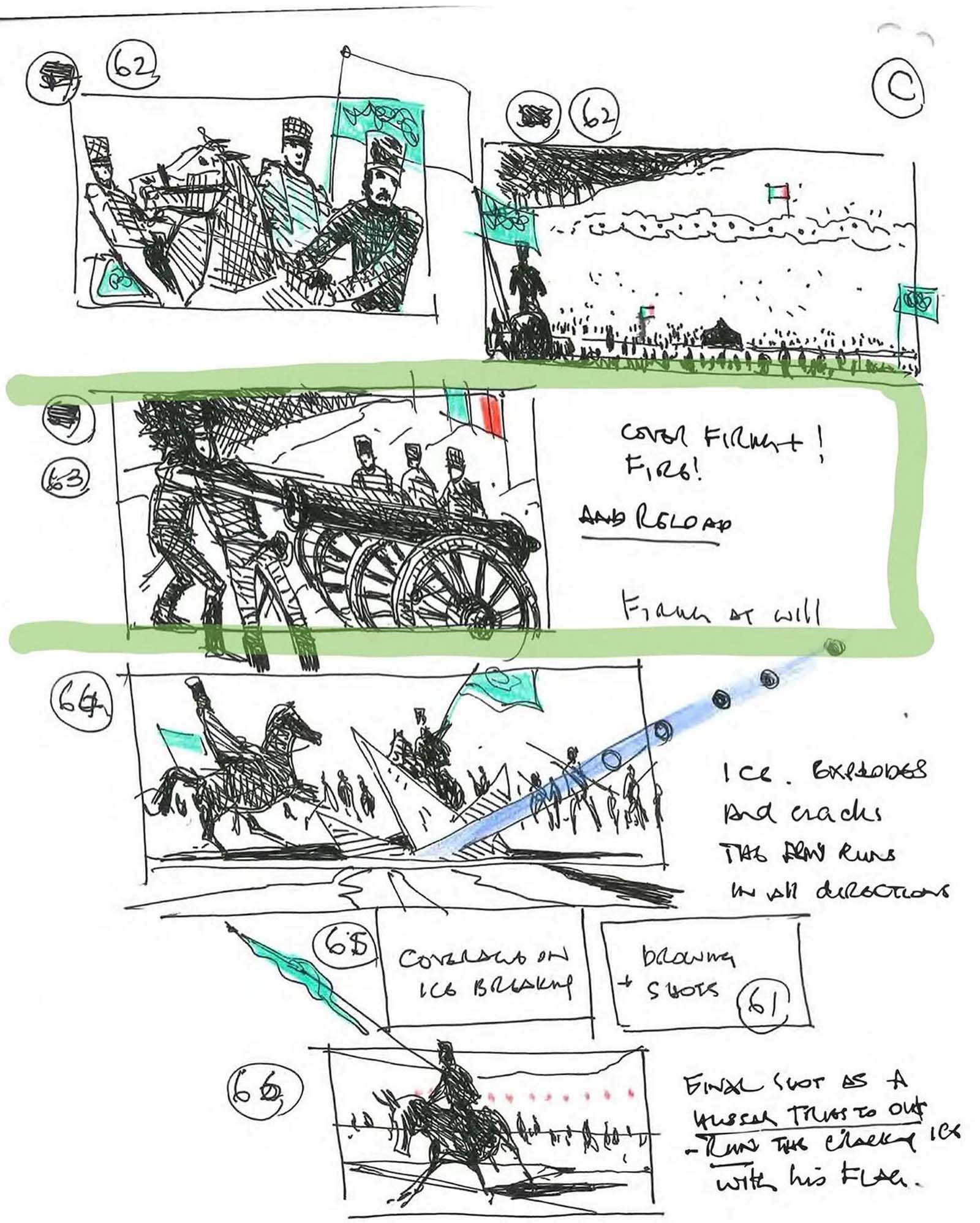
But yes, the storyboards get scanned and we have them in the Avid. We don’t necessarily cut with them because we don’t start cutting the sequence until we’ve got all the footage. Also, Ridley gets exactly what he drew. All of those shots showed up.
Ridley gave all of the heads department a very sweet crew gift. It was a leather-bound book of all the storyboards for Napoleon. And it’s gorgeous. It’s a stunning book. That’s something he does for every single movie. He draws every frame of the film.
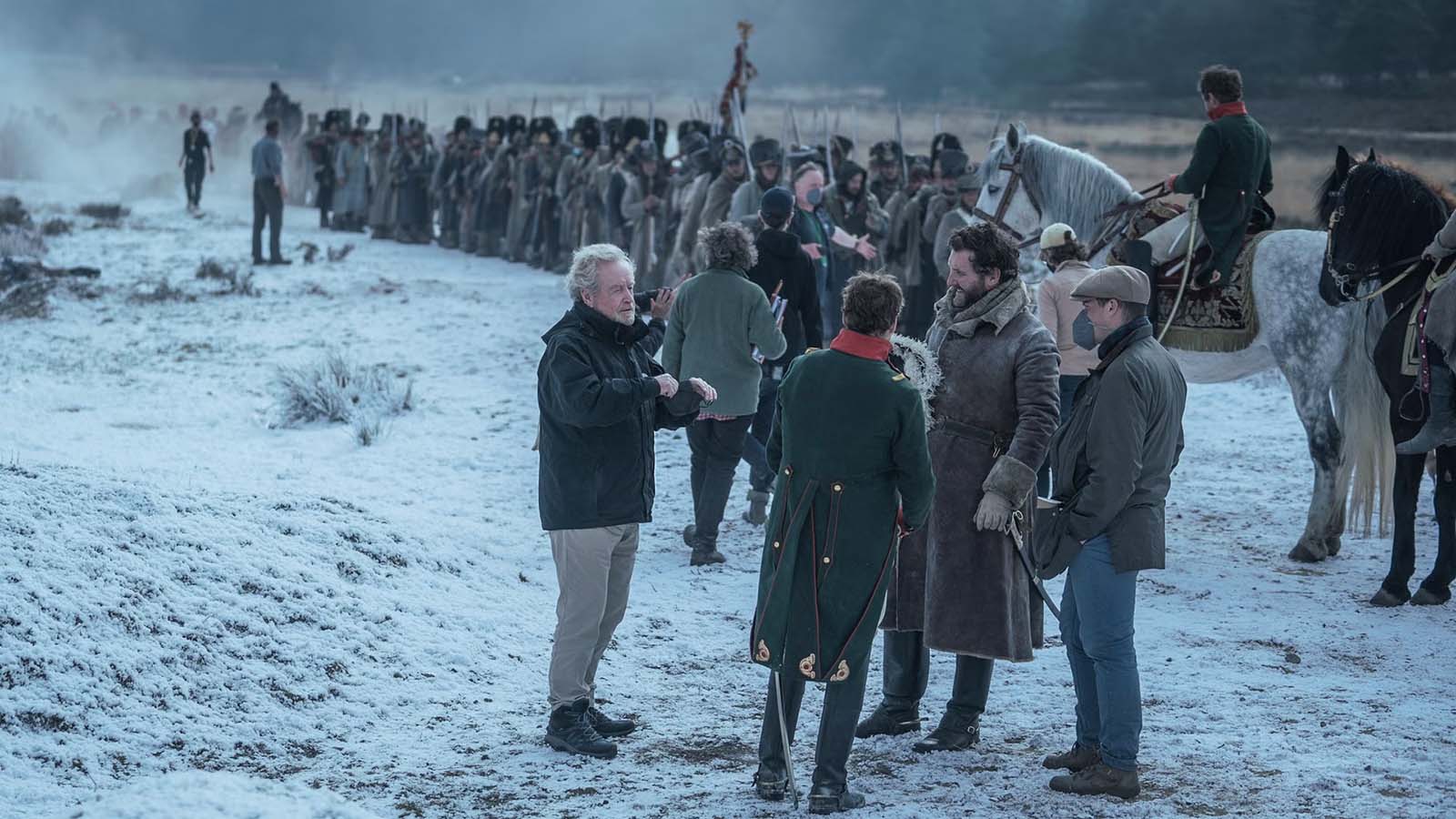
MF: That beats the hell out of a satin jacket. Right now, Claire is in Italy working on Gladiator 2. You’re working on it too, but you’re back here in the States. For Napoleon, were you on-site? Were you working from home? Do you have a preference either way for how you like to work?
Sam Restivo: Normally, we follow the production wherever they are. Amazingly, most of Napoleon was shot on location around England. Then we did three weeks in Malta at the very end. We were on location for all of that.
Ridley bounces between LA and the south of France. For the last few shows, he’s wanted us to be there for his director’s cut period, which is the official ten weeks after the end of the shoot. That’s where the director gets to do whatever they want with the movie. We spent those ten weeks in the south of France. Then we did all of the finishing in London. It’s a tough life for sure.
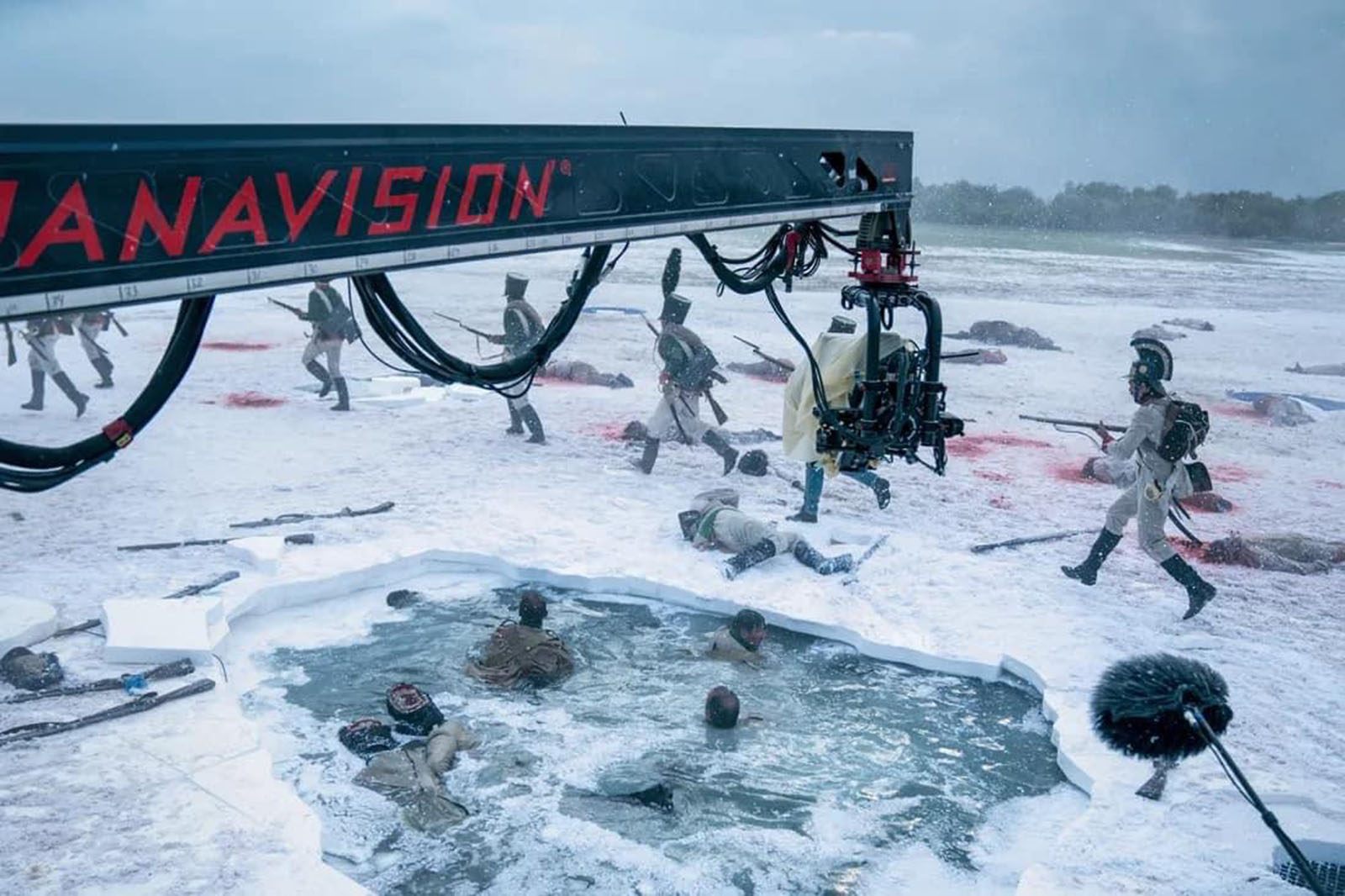
MF: I want to go back to the beginning of the film. The first character that we meet in the film is not Napoleon, but Marie Antoinette. It’s an interesting choice not to begin with Napoleon himself, but another famous figure in French history. I’d like to get a sense of how you and Claire put that opening sequence together. It feels very rock and roll. I don’t know why, but it’s just a wild sequence.
Sam Restivo: She looks like a rock star. You see, Napoleon was alive when Marie Antoinette was beheaded. Was he there? Who knows. We were making more of a thematic connection there than a historical one. Claire cut that sequence beautifully, I might add. She was the one who heard that Edith Piaf song and wanted to use it to set the tone of the movie. It’s a fascinating contrast and it makes it a slight rock-and-roll thing.
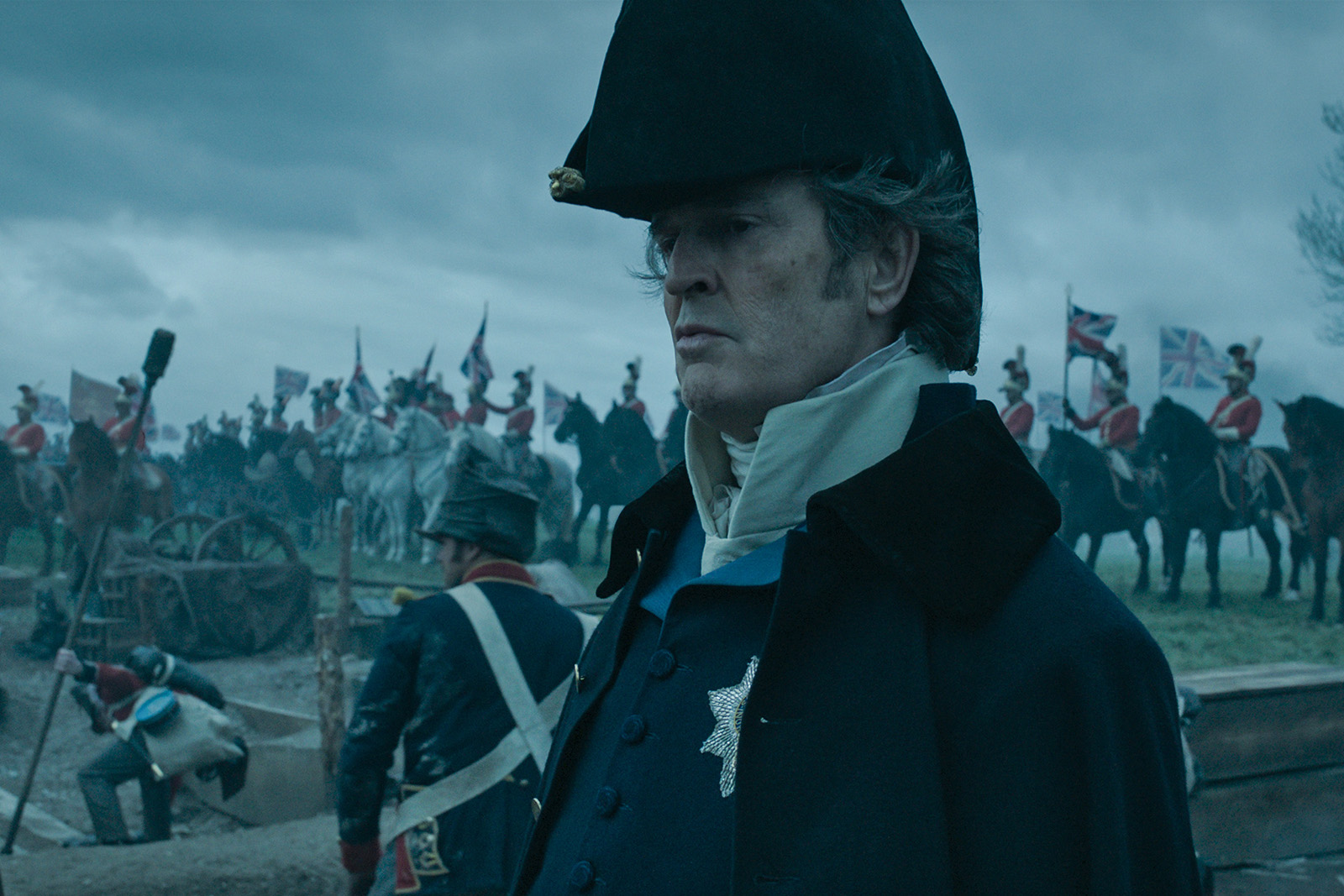
Ridley will shoot a lot of slow motion for some scenes. In that scene, he said, “Lean into it. Have this be a raucous environment where Marie Antoinette is being defiant toward the people who are plotting to kill her.” There was a question of which scene starts the movie. That scene just made the most sense to us.
That’s when the French Revolution gets going. From there, we can go directly to Robespierre, and then Robespierre gets his end as well. And this whole time, Napoleon is playing it cool. He’s letting things unfold because he wasn’t necessarily a royalist or an anti-royalist. He was just a soldier for the longest time, waiting for his moment to seize power.
MF: On the day, a director is marshaling a literal army to create these battle sequences, but you don’t know how it’s going to play out in the cutting room. I’ve heard you shoot a lot of primary beats, and then a lot of general crowd work, right?
Sam Restivo: Correct.
MF: How do you and Claire take those elements and create a cohesive battle sequence?
Sam Restivo: That was one of the biggest challenges. Claire did the Siege of Toulon. That was probably the hardest one because it was the most logistically challenging. On paper, it reads like, “Wait, where are these guys going? Who is shooting?” Sure, we had Ridley’s storyboards, but he’s not storyboarding what all eleven cameras shot, because on the day they’re all coming up with new frames and new angles.
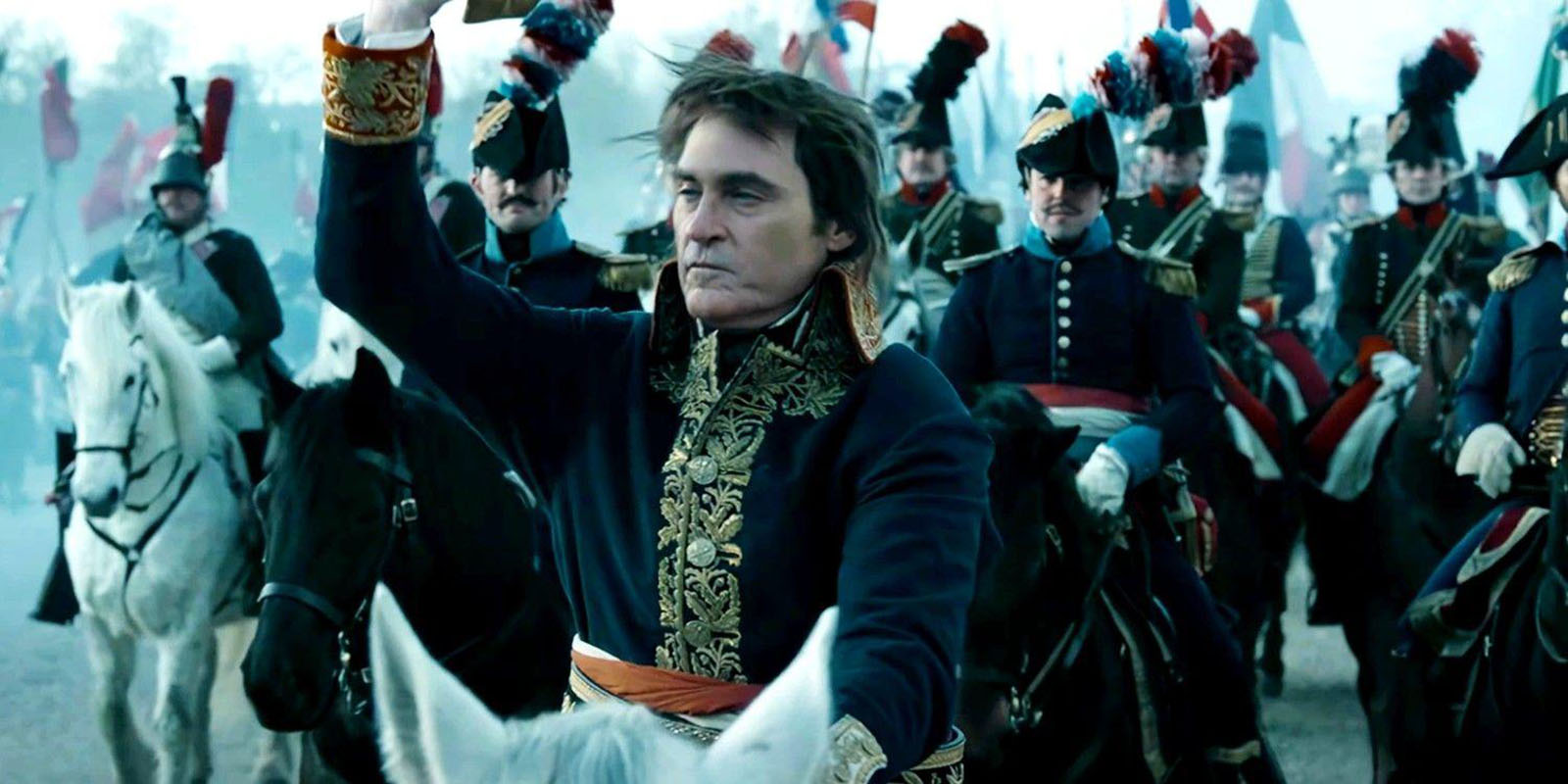
That’s the stuff that took the longest to put together. We had to approach it like we were just audience members who were trying to not get confused. We had to take it one shot at a time. Toulon was probably the most challenging. Austerlitz was the most laid out. I wouldn’t say it was simple, but at least it was clear about who the various parties were and how we were going to get to the end.
For Waterloo, we had very specific moments laid out in a sequence to explain how everything happened. It wasn’t too complicated to tell the story, it was just a challenge because of how much story there was. There are only so many charging horses you can show before it becomes monotonous. So it was about deciding how much of the battle to keep in.
There are only so many charging horses you can show before it becomes monotonous.
MF: How would you compare those sequences to something like the “look down” scene? The action stuff sometimes gives an editor a place to hide, but it’s trickier in the intimate scenes.
Sam Restivo: Yes, absolutely. The “look down” scene is a perfect example. It shows why Claire is the legend that she is. Her instincts and her experience informed that scene. She knew, “All right, we’re going to start in this beautifully composed wide shot of the two of them. Then, we are going to slowly get to the two close-ups.” She took her time with the cuts because it was about creating this mood, this tension between the two of them and sustaining it for a few minutes.
The punchline is the close-up on Joaquin. That moment where he looks down is such a brilliant piece of acting. Claire held that until the last possible frame, and it worked perfectly. I follow her lead on all things like that. It’s mainly about going back to the proper film editing grammar and understanding where the audience needs to be at a given moment. Then just keep it simple from there.
Don’t have too many cuts. That’s always the number one rule. Sometimes I would cut a scene and I would get too excited about all the different directions I could go. These actors always give us so many great moments to work with. I would show those cuts to Claire and she would say, “There’s too many cuts. It’s got to be simplified. It has to be the clearest version of the scene.” You’re not going to get every little thing that you want in, but you keep the best stuff.
Don’t have too many cuts. That’s always the number one rule.
MF: Let’s talk a little bit more about the brilliant things these actors are giving you. There’s a scene where Napoleon goes to visit Josephine after their divorce. He’s got his infamous hat on. Napoleon kisses her, his hat falls off, he puts it back on his head, and then he puts the hat on her head. That seemed so natural. Was that improv?
Sam Restivo: As far as we know, yes, it was, because that was a common thing. Joaquin and Vanessa always stick to the script for a few takes, but then they like to let the scene breathe a little bit. They want to stay focused on the emotions that they are playing with. So, they just get playful and let things happen.
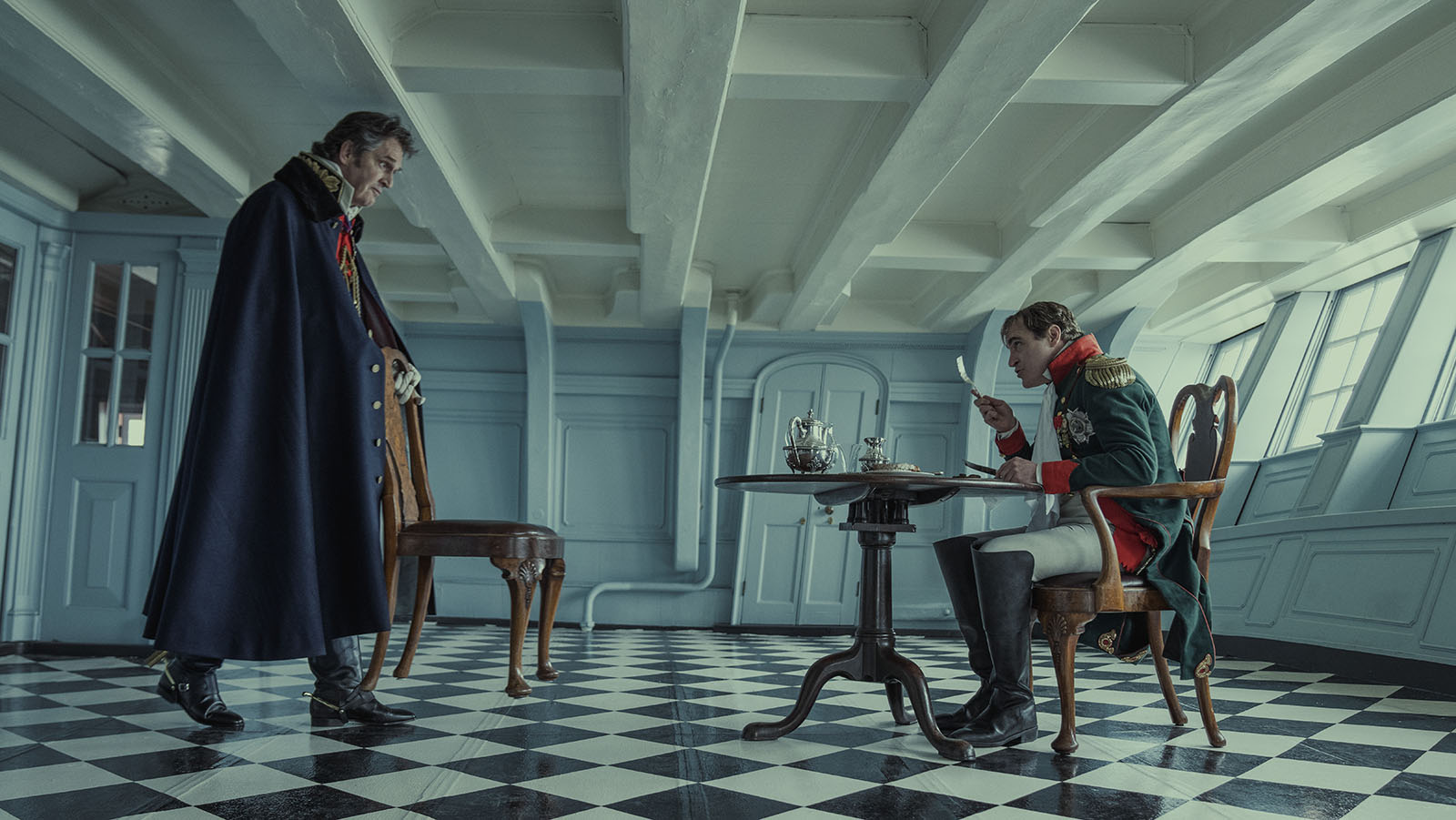
In that specific shot, and I honestly didn’t notice this at first, she knocked the hat off his head. He went in to kiss her, but she put her hand up and knocked the hat off his head. That’s part of her being playful. In the earlier sex scene, she knocked his hat off too, saying “Take the hat off.” Joaquin just rolled with it and put it on her head and had a fun moment with her.
MF: You did say that Ridley likes to be surprised by you and Claire in the cutting room. Is that improv specific to Joaquin and Vanessa? Or does Ridley encourage improv in general?
Sam Restivo: It depends on the script and what kind of film he’s making. On this one, the only improvising came from the two of them. Joaquin is such an amazing performer. When you’re watching him, he’s so engaging. You never know what’s going to happen. When Claire and I were watching the dailies, we were so focused on him.
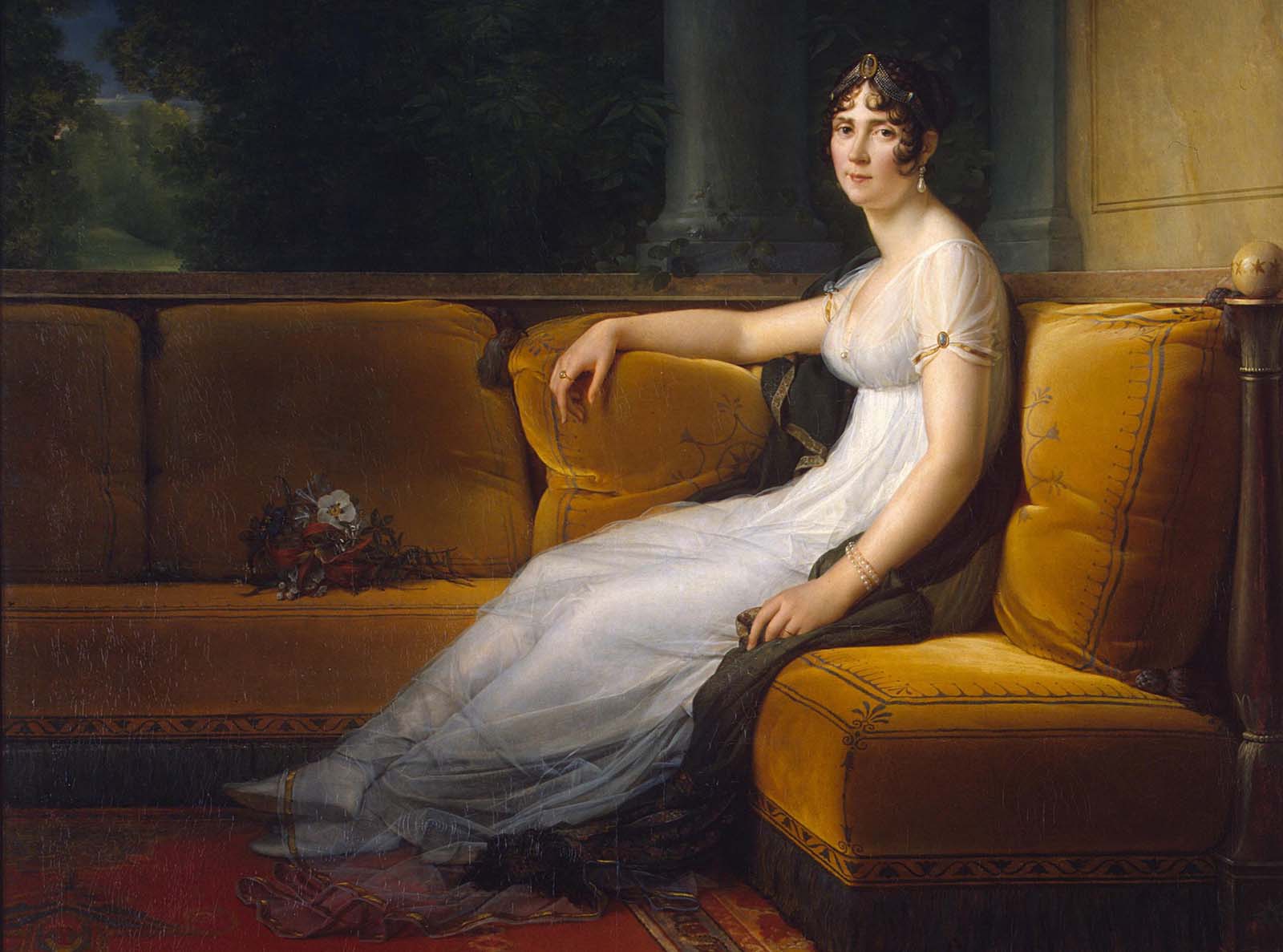
There were plenty of scenes where he stuck to the script entirely, but the one where the council interrogated him about why he abandoned his troops in Egypt was different. Joaquin improvised the take that we ended up using. That’s where he shushed them and then named all of the guys in the room. Claire and I thought, “Wow, that’s very useful. We can use that to identify the people in this scene.” And Ridley loved it because it felt authentic. It totally worked for us.
MF: You talked about the needle drops, which is not something I would have thought about. Score, sure, but needle drops? How do you go about doing that for something that takes place in this period?
Sam Restivo: Very carefully. But we had a fantastic music supervisor. Her name is Kathleen Wallfisch. In our discussions with Ridley well before the shoot, Kathleen gave us all of these amazing options. She’s the one who showed us the Edith Piaf version of the ‘Ça ira’ song.
We always knew it was going to be a combination of needle drops and the composer’s music. When you’re listening to classical music, it’s very stately and measured. It seems very prim and proper, and that makes an amazing contrast when paired with Napoleon in some of these scenes. The scenes are inherently comical by having this music in them.
That also happens with the needle drop during the coup sequence. You don’t think of that piece of music as a comical piece, but when it’s played against those performances, it’s hilarious.
MF: It seemed like you and Claire were often playing against what was happening with the music.
Sam Restivo: We were all on board with leaning into the satire whenever we could. From our perspective, the musical choices did the heaviest lifting for us.
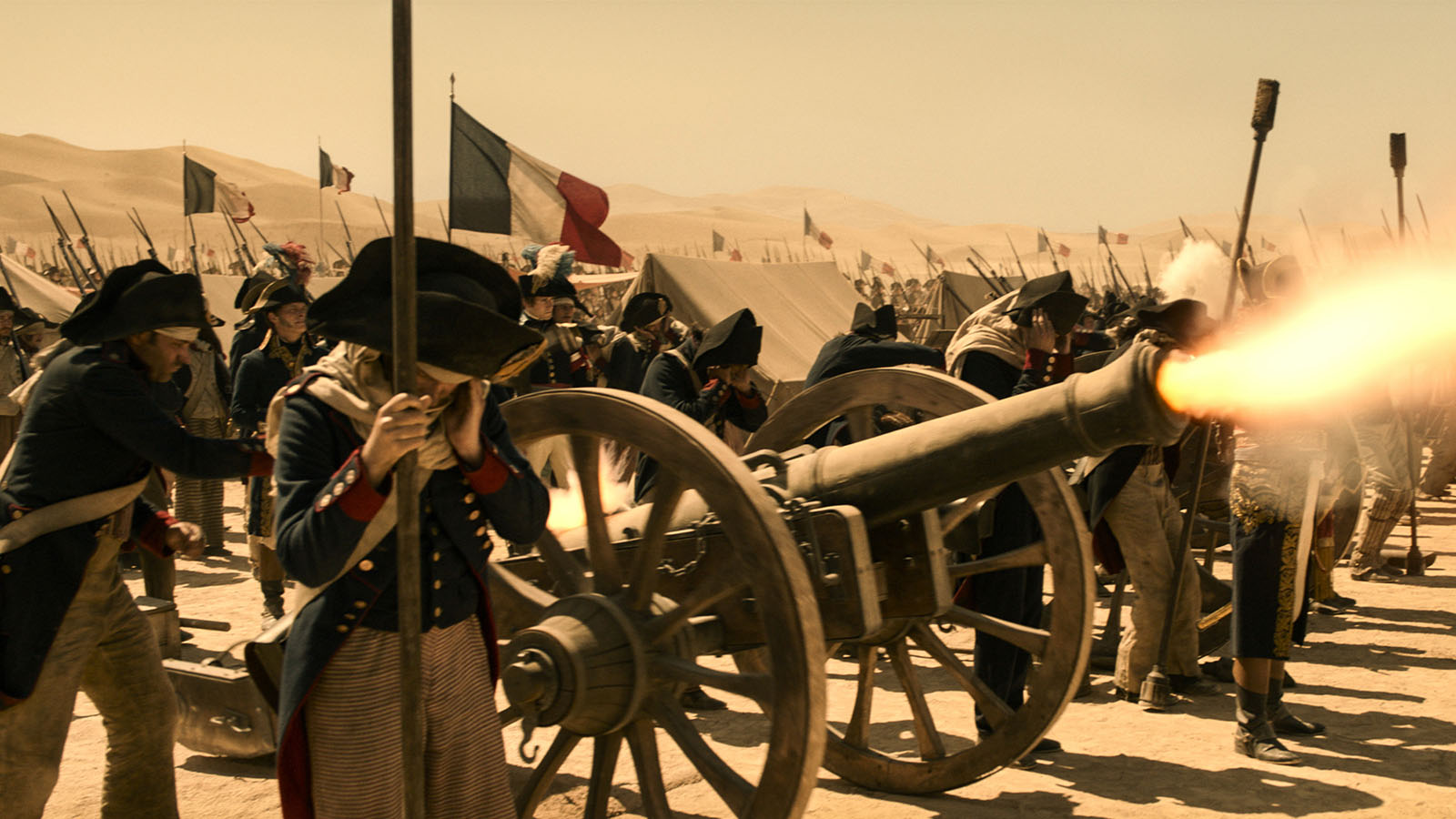
Having said that, we knew there were going to be moments where we wanted to have a fantastic original score. Martin Phipps just knocked it out of the park. He was trying to blend the score with the classical music that we were already using, but also give it a voice. Specifically, and this was a Ridley request, he wanted it to have Corsican voices. Ridley wanted to be able to go back within the music and remember where Napoleon came from.
That starts in Austerlitz. We bring in the Corsican Voices for maybe the first time. The music brings us back to just this one guy and where he’s from. For us, it just works beautifully.
MF: The sound design is so crucial to making these battle scenes work. Tell me a little bit about sound design for Napoleon. Were you working in 5.1 to help with the Atmos aspect of it?
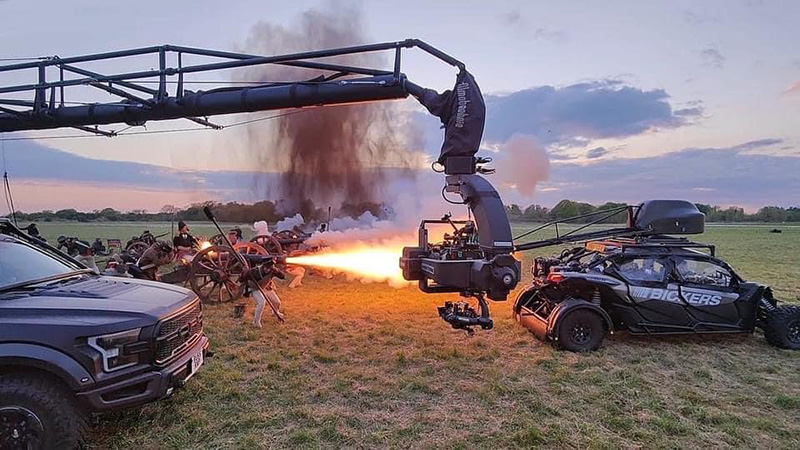
Sam Restivo: Claire and I just do LCR mixing. It’s less complicated for us editorially. A movie like this has so many tracks. We need to keep things simple. We also have a trusted sound editorial team led by Oliver Tarney and James Harrison. We also had the master of sound mixing, Paul Massey and Will Miller. We knew that we were going to be fine.
I was an assistant for a long time and I had to do lots and lots of sound work. That’s one of the skills that I can bring to the table. When we were first showing Ridley cuts of the movie, before even bringing in any of the sound editorials, we were making it very presentational by adding lots of sound effects. Design-wise, we were deciding where we were going to push music and where we were going to push effects.
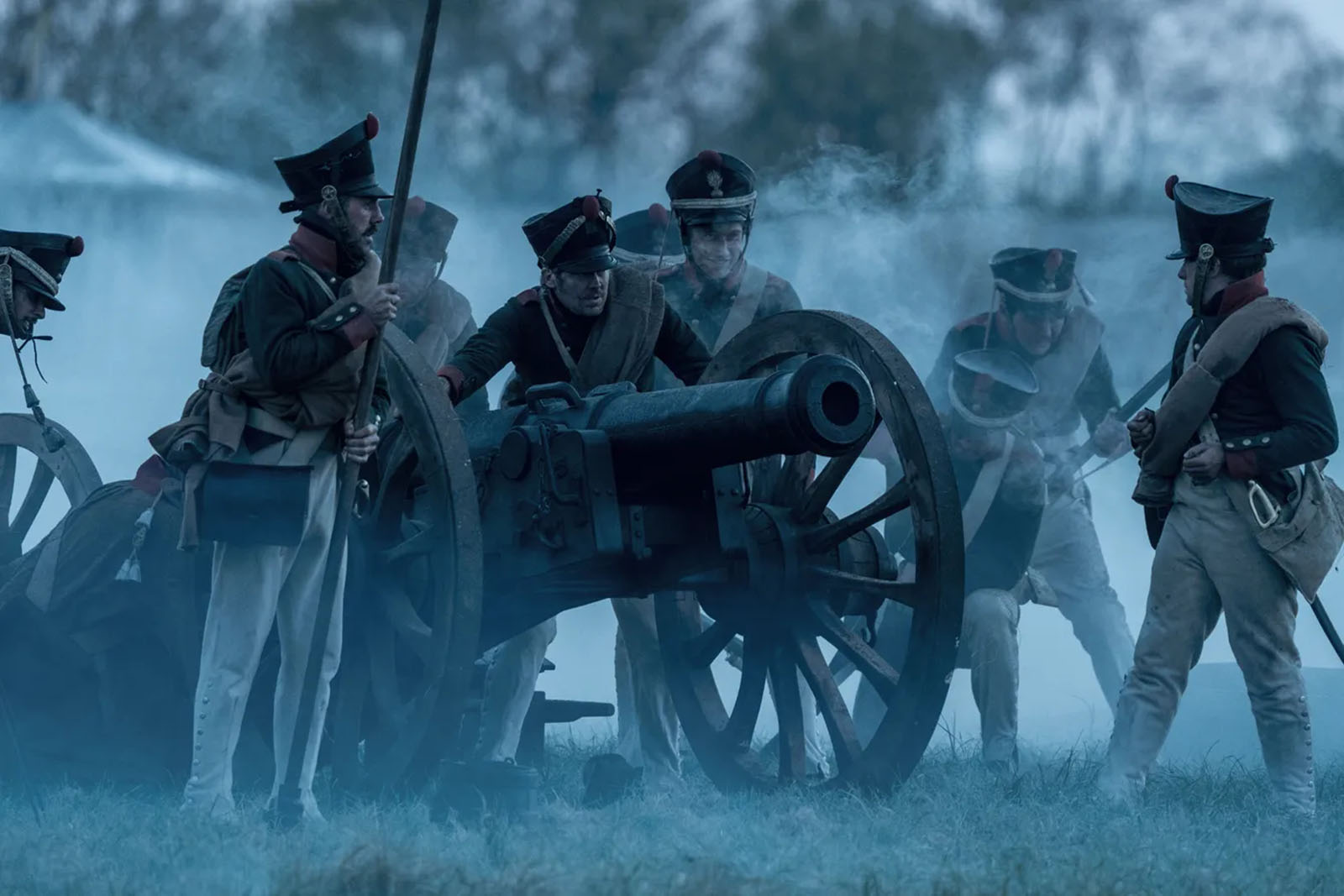
Napoleon is a giant film with big battles. We were always cognizant of not wanting it to be too big, too fast, or too sustained. Oliver and James specifically breathed life into the battle scenes. They added little things like repeated orders and sounds from the guys in the field. All that rounds out the sonic environment.
On the music side, we had a fabulous music editor named Tony Lewis. When we got to Waterloo, for example, there were different types of drums being played for both the French side and the British side. That just adds this extra layer of character to the scene. All of those things come together when we finally get to the mix stage with Paul and Will. It all comes together beautifully and becomes a real movie.
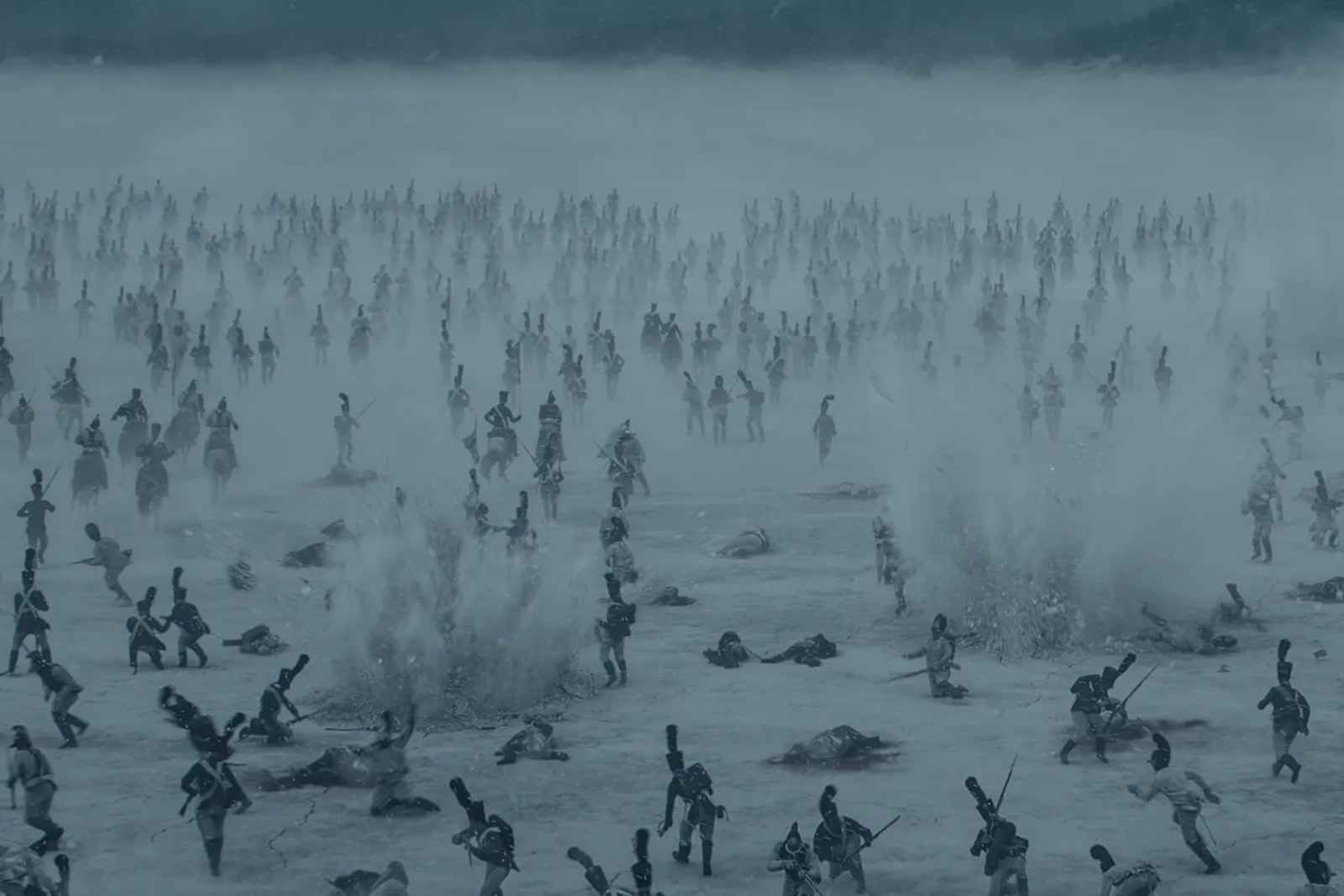
We are always trying to build the sound from the very beginning. On Napoleon, we had at least one sound editor on staff during production to help us out. For the Royalists insurrection scene, we wanted some dialog cleanup and also some effects help and they were already on board during production to us out. That was a fantastic collaboration.
MF: When you’re editing a movie, you start by working off a twenty-inch screen maybe, or even an OLED screen in your cutting room. But then you see it displayed wide on a real screen. Did you find that the movie played differently when you were watching it projected theatrically? Did you have to make changes after seeing it on a big screen?
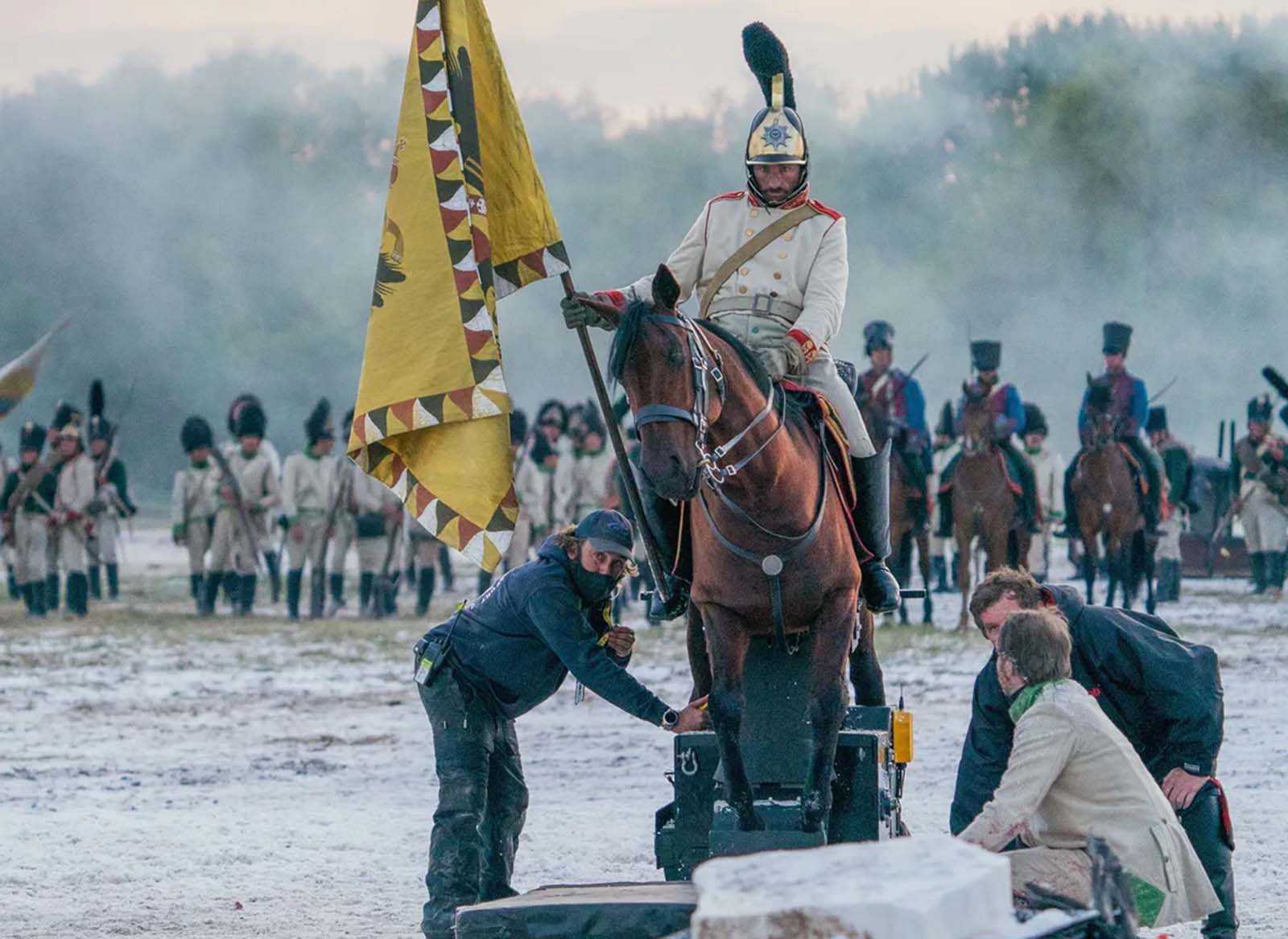
Sam Restivo: Yes, there’s always a difference. We have a sixty-five-inch OLED 4K monitor that Ridley loves because the contrast ratio is fabulous and the colors look great. It’s not too far off from what the movie is going to look like. But we also watch it on the big screen, especially to judge visual effects.
I wouldn’t say we made changes just because we saw it in the theater. We were pretty confident. But the conversion to IMAX was fascinating. That happened very late in the game. We weren’t reviewing reels of it or anything while we were cutting. It was only after Sony had agreed to distribute the film that that took place. I just got to watch the first two reels of the movie in IMAX two weeks ago. IMAX is a wildly different experience. It is super cool. It’s so immersive and the sound is so overwhelming. I can’t wait to go see it like that. I encourage everyone I know to go see an IMAX.

MF: In general, do you like to edit with audio in place or do you like to cut the scene visually and then work with the audio?
Sam Restivo: I cut with the audio. It’s always a little bit complicated. It depends on the scene though. These battle scenes are all shot at different frame rates. Our assistant editors, led by first assistant Danielle El-Hendi, get everything to 24fps and sync it with the audio that way. Then we can always match back to the slower frame rate stuff.
We always have the sound available unless they went MOS (no sound), which wasn’t often. I usually cut with the sound. Claire might do more stuff without, but I don’t recall how that worked there.
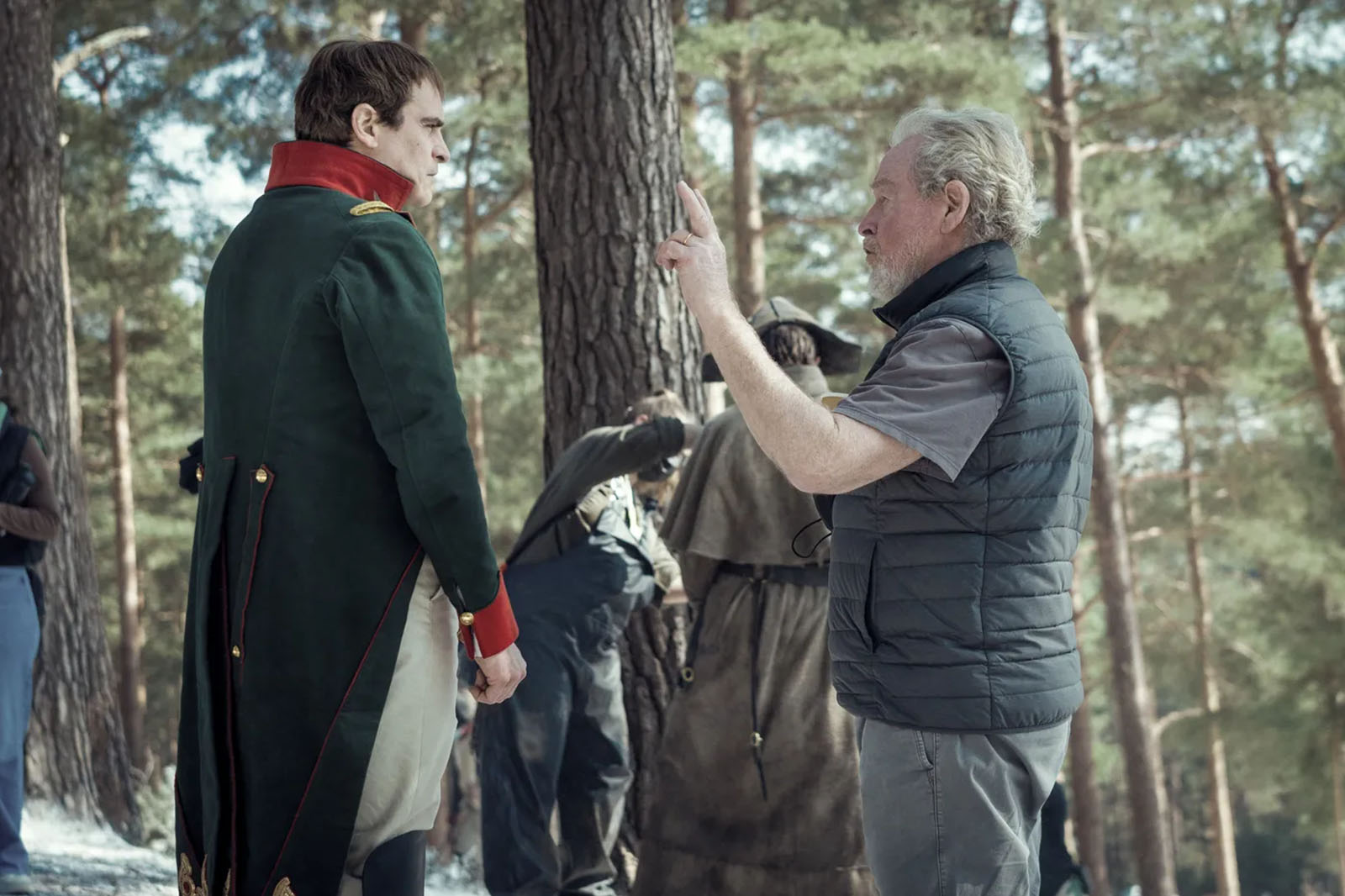
MF: So you talked about Claire mentoring you and you just brought up your assistant crew. You also mentioned that sound work was a big part of what you did as an assistant. What do you need or look for in an assistant?
Sam Restivo: Organization is the number one thing. I’m a fastidious person and don’t like having too many bins, or too many folders. I want the timeline tracks arranged properly where dialog is in one through four, mono effects are in five through eight, stereo effects in nine to fourteen, and then music after that. Organization is a big thing. Having sound skills is a plus, but that’s something I learned on the job. Honestly, I didn’t just have that naturally. That got drilled into me by previous editors that I work with.
Organization is the number one thing.
We had one of the best visual effects editors, Michael Cheung. He was great about doing quick comps. Ridley is always available to see things before they’re complete visually, but it always helps to have it temped out as quickly as possible. I also knew how to do some compositing when I was an assistant. It was just quick stuff using the Avid, not necessarily After Effects or any other programs. Avid has perfectly fine tools for that. I survived by just doing quick comps using Avid.
MF: Unfortunately, Claire couldn’t join us today because she’s over in Italy. She’s done Wall Street, she won an Oscar for Platoon and was nominated for The Constant Gardener. Then, of course, there’s all the films that she’s done with Ridley Scott. Which one do you ask her about the most, Platoon or C.H.U.D., her first feature?
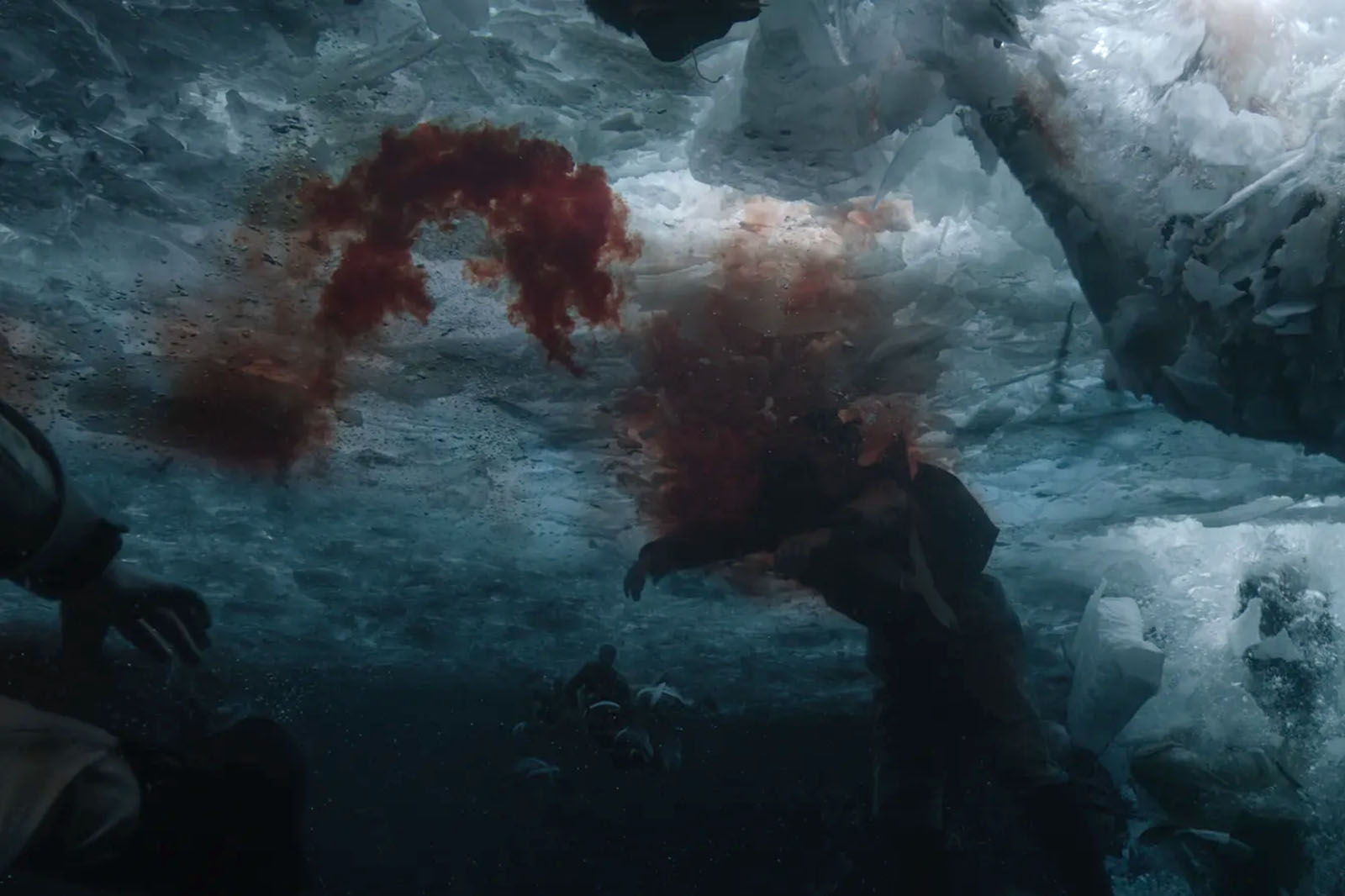
Sam Restivo: I always ask her about everything. But the cutting room she ran on Wall Street is unbelievable. It was Claire Simpson, ACE, Joe Hutshing, ACE Pietro Scalia, ACE, David Brenner, ACE, Julie Monroe, ACE, and Mark Livolsi, ACE. All of those people are absolute legends. Before I worked with Claire, I worked with Joe Hutsing on several films. He’s another fantastic mentor to me.
Claire is also such a special person and such a special editor. She wants to bring you into the process with open arms. She is very supportive. I wouldn’t have this opportunity if it wasn’t for her championing me and telling Ridley that she wanted to share credit with me.
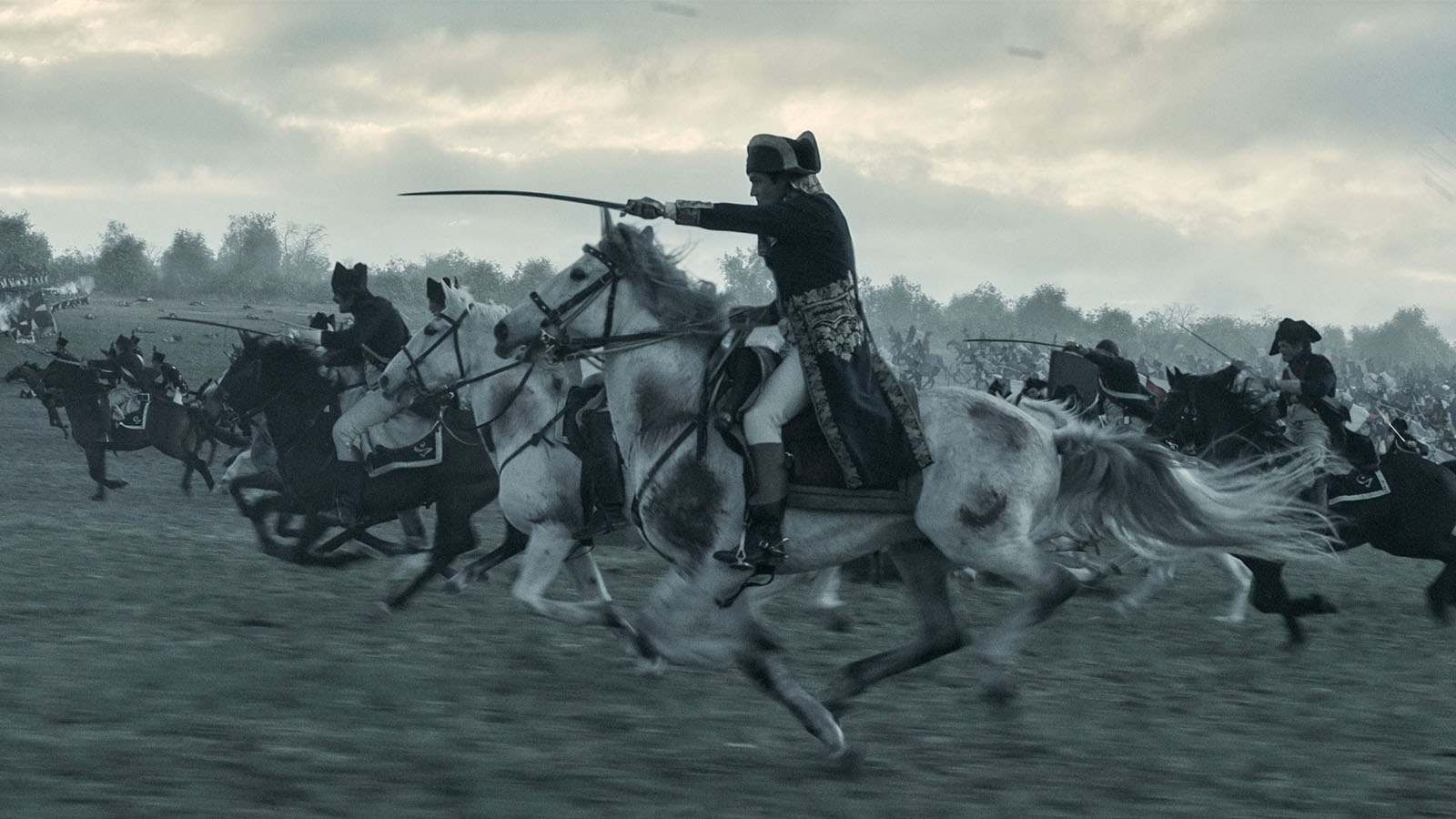
All the Money in the World is another fascinating one. They had to replace Kevin Spacey. They were completely done and they had to bring everybody back together and make it happen in no time. And Christopher Plummer got an Academy Award nomination for his performance.
Something else about Claire, the amount of actors that she has edited to Academy Award nominations and wins is staggering. Kate Winslet, The Reader. Rachel Weisz, The Constant Gardener. Michael Douglas in Wall Street. I think actors are very lucky when she is the editor because it’s probably going to turn out well for them.

MF: Sam, be honest with me. Do you think she bailed out because she thought I was going to bring up C.H.U.D.”
Sam Restivo: No, she loves C.H.U.D. It’s a hilarious, fantastic movie. That was her first movie and she had a blast doing that.
MF: All right. You tell her that I want to talk about that one someday.
Sam Restivo: I will. I will.

